

Reducing social media use significantly improves body image in teens, young adults
- Social Media and Internet
Participants saw results in weeks, study says
Read the journal article
- Reducing Social Media Use Improves Appearance and Weight Esteem in Youth With Emotional Distress (PDF, 951KB)
Washington — Teens and young adults who reduced their social media use by 50% for just a few weeks saw significant improvement in how they felt about both their weight and their overall appearance compared with peers who maintained consistent levels of social media use, according to research published by the American Psychological Association.
“Adolescence is a vulnerable period for the development of body image issues, eating disorders and mental illness,” said lead author Gary Goldfield, PhD, of Children’s Hospital of Eastern Ontario Research Institute. “Youth are spending, on average, between six to eight hours per day on screens, much of it on social media. Social media can expose users to hundreds or even thousands of images and photos every day, including those of celebrities and fashion or fitness models, which we know leads to an internalization of beauty ideals that are unattainable for almost everyone, resulting in greater dissatisfaction with body weight and shape.”
However, much of the psychological research on social media, body image and mental health is correlational, according to Goldfield, so it is uncertain whether people with body image and mental health issues spend more time on social media or if social media use leads to greater body image and mental health issues.
To better understand the causal effects of reducing social media use on body image, Goldfield and his colleagues previously conducted a pilot study with 38 undergraduate students with elevated levels of anxiety and/or depression. Some of the participants were asked to limit their social media use to no more than 60 minutes per day, while others were allowed unrestricted access. Compared with participants who had unlimited access, participants who restricted their use showed improvements in how they regarded their overall appearance (but not their weight) after three weeks. Due to the small sample size, though, the researchers were unable to conduct a meaningful analysis of the effect of gender.
The current experiment, involving 220 undergraduate students aged 17–25 (76% female, 23% male, 1% other) and published in the journal Psychology of Popular Media , sought to expand the pilot study and address the gender limitation. In order to qualify, participants had to be regular social media users (at least two hours per day on their smartphones) and exhibit symptoms of depression or anxiety.
For the first week of the experiment, all participants were instructed to use their social media as they normally would. Social media use was measured using a screentime tracking program to which participants provided a daily screenshot. After the first week, half the participants were instructed to reduce their social media use to no more than 60 minutes per day. At the start of the experiment, participants also responded to a series of statements about their overall appearance (e.g., “I’m pretty happy about the way I look”) and weight (e.g., “I am satisfied with my weight”) on a 5-point scale, with 1 indicating “never” and 5 “always.” Participants completed a similar questionnaire at the end of the experiment.
For the next three weeks, participants who were instructed to restrict their social media use reduced it by approximately 50% to an average of 78 minutes per day versus the control group, which averaged 188 minutes of social media use per day.
Participants who reduced their social media use had a significant improvement in how they regarded both their overall appearance and body weight after the three-week intervention, compared with the control group, who saw no significant change. Gender did not appear to make any difference in the effects.
“Our brief, four-week intervention using screentime trackers showed that reducing social media use yielded significant improvements in appearance and weight esteem in distressed youth with heavy social media use,” said Goldfield. “Reducing social media use is a feasible method of producing a short-term positive effect on body image among a vulnerable population of users and should be evaluated as a potential component in the treatment of body-image-related disturbances.”
While the current study was conducted as a proof of concept, Goldfield and his colleagues are in the process of conducting a larger study to see if reduction in social media use can be maintained for longer periods and whether that reduction can lead to even greater psychological benefits.
Article: “Reducing Social Media Use Improves Appearance and Weight Esteem in Youth with Emotional Distress,” by Helen Thai, BA, McGill University; Christopher Davis, PhD, Wardah Mahboob, MA, Sabrina Perry, BA, and Alex Adams, BA, Carleton University; and Gary Goldfield, PhD, Children’s Hospital of Eastern Ontario. Psychology of Popular Media , published online Feb. 23, 2023.
Gary Goldfield, PhD, can be contacted via email .
Jim Sliwa (202) 336-5707
- Social media and the internet Psychology topic
- APA chief scientist outlines potential harms, benefits of social media for kids Press release
- Why young brains are especially vulnerable to social media Article
- How social media affects teens’ mental health and well-being Podcast episode
- Share full article
Advertisement
Supported by
current events conversation
What Students Are Saying About How Social Media Affects Their Body Image
A recent article put a spotlight on how social media can fuel body dysmorphia in boys. We asked teenagers how these apps make them feel about the way they look.

By The Learning Network
Please note: This post is part of The Learning Network’s ongoing Current Events Conversation feature in which we invite students to react to the news via our daily writing prompts and publish a selection of their comments each week.
In “ What Is ‘Bigorexia’? ” Alex Hawgood reports on a social media landscape dominated by muscle-building content and fitness influencers, and how it affects the way increasing numbers of teenage boys feel about their own bodies.
As we regularly do when The Times writes about an issue that touches the lives of young people, we used our daily Student Opinion forum to ask teenagers to share their perspectives on social media and body image.
Many students said that social media has been “detrimental” to the way they feel about their looks, and that even though they are aware it doesn’t show the full picture, they still struggle not to compare themselves to the people they see online. They grappled, too, with the heart of the article: male body image issues and why boys and men might have a harder time talking about them. And others shared that sometimes social media can be a positive influence on their health, motivating them to make changes or just accept their bodies the way they are.
Thank you to all those from around the world who joined the conversation this week, including teenagers from Great Neck, N.Y.; Lake Travis High School in Austin, Texas; and Taiwan .
We are having trouble retrieving the article content.
Please enable JavaScript in your browser settings.
Thank you for your patience while we verify access. If you are in Reader mode please exit and log into your Times account, or subscribe for all of The Times.
Thank you for your patience while we verify access.
Already a subscriber? Log in .
Want all of The Times? Subscribe .
Adolescents’ Body Shame and Social Networking Sites: The Mediating Effect of Body Image Control in Photos
- Original Article
- Published: 25 March 2020
- Volume 83 , pages 773–785, ( 2020 )
Cite this article

- Francesca Gioia 1 ,
- Mark D. Griffiths 2 &
- Valentina Boursier 1
10k Accesses
39 Citations
3 Altmetric
Explore all metrics
Adolescents’ social networking site (SNS) use has dramatically grown in the past few years and has increasingly become focused on pictures and visual self-presentation. Attention directed toward online physical appearance appears to trigger some body-related behaviors (e.g., body image monitoring) which potentially are related to self-objectification and problematic SNS use. Indeed, the use of social media platforms (including the active creation of content and peer interactions) provides a highly accessible medium for socializing with self-objectification. The present study evaluated the previously unexplored predictive role of body shame on SNS use, testing the mediating effect of body image control in photos on SNS. A total of 693 Italian adolescents (45% male; M age = 16 years, range = 13–19 years) participated in the study. Results only partially confirmed the direct effect of body shame on problematic SNS use. However, body shame strongly predicted body image control in SNS photos, leading indirectly to both male and female adolescents’ problematic social media use. The study demonstrated novel findings in the field of self-objectification research and contributes toward the ongoing debate on possible predictors of problematic SNS use.
This is a preview of subscription content, log in via an institution to check access.
Access this article
Price includes VAT (Russian Federation)
Instant access to the full article PDF.
Rent this article via DeepDyve
Institutional subscriptions

Similar content being viewed by others

Body shame and problematic social networking sites use: the mediating effect of perfectionistic self-presentation style and body image control in photos

Body Image Comparisons on Social Networking Sites and Chinese Female College Students’ Restrained Eating: The Roles of Body Shame, Body Appreciation, and Body Mass Index
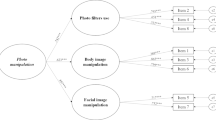
What about young adults’ photo manipulation activity? The predictive role of body shame and the mediating effect of body esteem
Andreassen, C. S., Billieux, J., Griffiths, M. D., Kuss, D. J., Demetrovics, Z., Mazzoni, E., … Pallesen, S. (2016). The relationship between addictive use of social media and video games and symptoms of psychiatric disorders: A large-scale cross-sectional study. Psychology of Addictive Behaviors, 30 (2), 252–262. https://doi.org/10.1037/adb0000160 .
Article Google Scholar
Andrew, R., Tiggemann, M., & Clark, L. (2016). Predicting body appreciation in young women: An integrated model of positive body image. Body Image, 18 , 34–42. https://doi.org/10.1016/j.bodyim.2016.04.003 .
Article PubMed Google Scholar
Arroyo, A., & Brunner, S. R. (2016). Negative body talk as an outcome of friends’ fitness posts on social networking sites: Body surveillance and social comparison as potential moderators. Journal of Applied Communication Research, 44 (3), 216–235. https://doi.org/10.1080/00909882.2016.1192293 .
Aubrey, J. S. (2006). Exposure to sexually objectifying media and body self-perceptions among college women: An examination of the selective exposure hypothesis and the role of moderating variables. Sex Roles, 55 (3–4), 159–172. https://doi.org/10.1007/s11199-006-9070-7 .
Baker, R. K., & White, K. M. (2010). Predicting adolescents’ use of social networking sites from an extended theory of planned behaviour perspective. Computers in Human Behavior, 26 (6), 1591–1597. https://doi.org/10.1016/j.chb.2010.06.006 .
Balakrishnan, J., & Griffiths, M. D. (2017). Social media addiction: What is the role of content in YouTube ? Journal of Behavioral Addictions, 6 , 364–377. https://doi.org/10.1556/2006.6.2017.058 .
Article PubMed PubMed Central Google Scholar
Bányai, F., Zsila, Á., Király, O., Maraz, A., Elekes, Z., Griffiths, M. D., … Demetrovics, Z. (2017). Problematic social media use: Results from a large-scale nationally representative adolescent sample. Plos One, 12 (1), 1–13. https://doi.org/10.6084/m9.figshare.4479434 .
Barzoki, M. H., Mohtasham, L., Shahidi, M., & Tavakol, M. (2017). Self-objectification and self-sexualization behavior within consumer culture. Applied Research in Quality of Life, 12 (2), 425–438. https://doi.org/10.1007/s11482-016-9468-5 .
Bell, B. T., Cassarly, J. A., & Dunbar, L. (2018). Selfie-objectification: Self-objectification and positive feedback (“likes”) are associated with frequency of posting sexually objectifying self-images on social media. Body Image, 26 , 83–89. https://doi.org/10.1016/j.bodyim.2018.06.005 .
Bentler, P. M. (1990). Comparative fit indexes in structural models. Psychological Bulletin, 107 (2), 238–246 https://escholarship.org/uc/item/6cn677bx .
Bianchi, D., Morelli, M., Baiocco, R., & Chirumbolo, A. (2017). Sexting as the mirror on the wall: Body-esteem attribution, media models, and objectified-body consciousness. Journal of Adolescence, 61 , 164–172. https://doi.org/10.1016/j.adolescence.2017.10.006 .
Billieux, J., Schimmenti, A., Khazaal, Y., Maurage, P., & Heeren, A. (2015). Are we overpathologizing everyday life? A tenable blueprint for behavioral addiction research. Journal of Behavioral Addictions, 4 (3), 119–123. https://doi.org/10.1556/2006.4.2015.009 .
Boursier, V., & Manna, V. (2018a). Problematic linkages in adolescents: Italian adaptation of a measure for internet-related problems. In B. Bozoglan (Ed.), Psychological, social, and cultural aspects of internet addiction (pp. 253–282). Hershey, PA: IGI Global. https://doi.org/10.4018/978-1-5225-8900-6.ch015 .
Chapter Google Scholar
Boursier, V., & Manna, V. (2018b). Selfie expectancies among adolescents. Construction and validation of an instrument to assess expectancies toward selfies among boys and girls. Frontiers in Psychology, 9, 839. https://doi.org/10.3389/fpsyg.2018.00839 .
Boursier, V., & Manna, V. (2019). Relational body identities: Body image control through self-portraits –a revision of the body image control in photos questionnaire. In R. T. Gopalan (Ed.), Intimacy and developing personal relationships in the virtual world (pp. 40–63). Hershey, PA: IGI Global. https://doi.org/10.4018/978-1-5225-4047-2.ch003 .
Boursier, V., Manna, V., Gioia, F., Coppola, F., & Venosa, N. (2018). Cyber-moms facing motherhood: Holding functions and regressive movements in parenting websites. In S. Sekalala & B. C. Niezgoda (Eds.), Global perspectives on health communication in the age of social media (pp. 29–58). Hershey, PA: IGI Global. https://doi.org/10.4018/978-1-5225-3716-8.ch002 .
Boursier, V., Gioia, F., & Griffiths, M. D. (2020a). Objectified body consciousness, body image control in photos, and problematic social networking: The role of appearance control beliefs. Frontiers in Psychology, 11 (147), 1–11. https://doi.org/10.3389/fpsyg.2020.00147 .
Boursier, V., Gioia, F., & Griffiths, M. D. (2020b). Selfie-engagement on social media: Pathological narcissism, positive expectation, and body objectification–which is more influential? Addictive Behaviors Reports. Advance online publication. https://doi.org/10.1016/j.abrep.2020.100263 .
Boyd, D. M., & Ellison, N. B. (2007). Social network sites: Definition, history, and scholarship. Journal of Computer-Mediated Communication, 13 (1), 210–230. https://doi.org/10.1111/j.1083-6101.2007.00393.x .
Browne, M. W., & Cudeck, R. (1993). Alternative ways of assessing model fit. In K. A. Bollen & J. S. Long (Eds.), Testing structural equation models (pp. 136–162). Newbury Park, CA: Sage.
Google Scholar
Butkowski, C. P., Dixon, T. L., & Weeks, K. (2019). Body surveillance on Instagram: Examining the role of selfie feedback investment in young adult women’s body image concerns. Sex Roles . Advance online publication. https://doi.org/10.1007/s11199-018-0993-6 .
Caplan, S. E. (2003). Preference for online social interaction: A theory of problematic internet use and psychosocial well-being. Communication Research, 30 (6), 625–648. https://doi.org/10.1177/0093650203257842 .
Caplan, S. E. (2007). Relations among loneliness, social anxiety, and problematic internet use. Cyberpsychology & Behavior, 10 (2), 234–242. https://doi.org/10.1089/cpb.2006.9963 .
Caplan, S. E. (2010). Theory and measurement of generalized problematic internet use: A two-step approach. Computers in Human Behavior, 26 (5), 1089–1097. https://doi.org/10.1016/j.chb.2010.03.012 .
Casale, S., & Fioravanti, G. (2017). Shame experiences and problematic social networking sites use: An unexplored association. Clinical Neuropsychiatry , 14 (1), 44-48. https://flore.unifi.it/retrieve/handle/2158/1074075/212427/2017_shame_PIU_Clin_Neur.pdf .
Caso, D., Fabbricatore, R., Muti, F., & Starace, C. (2019). Sessualizzazione e oggettivazione femminile su Instagram: il ruolo delle influencer [Female sexualization and objectification on Instagram: The role of the influencers]. Psicologia Sociale, 3 , 441–463. https://doi.org/10.1482/94944 .
Chen, J., Ishii, M., Bater, K. L., Darrach, H., Liao, D., Huynh, P. P., … Ishii, L. E. (2019). Association between the use of social media and photograph editing applications, self-esteem, and cosmetic surgery acceptance. JAMA Facial Plastic Surgery, 21 (5), 361–367. https://doi.org/10.1001/jamafacial.2019.0328 .
Cohen, R., Newton-John, T., & Slater, A. (2017). The relationship between Facebook and Instagram appearance-focused activities and body image concerns in young women. Body Image, 23 , 183–187. https://doi.org/10.1016/j.bodyim.2017.10.002 .
Cohen, R., Newton-John, T., & Slater, A. (2018). ‘Selfie’-objectification: The role of selfies in self-objectification and disordered eating in young women. Computers in Human Behavior, 79 , 68–74. https://doi.org/10.1016/j.chb.2017.10.027 .
Craparo, G., Messina, R., Severino, S., Fasciano, S., Cannella, V., Gori, A., … Baiocco, R. (2014). The relationships between self-efficacy, internet addiction and shame. Indian Journal of Psychological Medicine, 36 (3), 304–307 https://www.ncbi.nlm.nih.gov/pmc/articles/PMC4100419/ .
D’Arienzo, M. C., Boursier, V., & Griffiths, M. D. (2019). Addiction to social media and attachment styles: A systematic literature review. International Journal of Mental Health and Addiction, 17 , 1094–1118. https://doi.org/10.1007/s11469-019-00082-5 .
Dakanalis, A., Di Mattei, V. E., Prunas, A., Riva, G., Sarno, L., Volpato, C., … Zanetti, M. A. (2012). Il corpo oggettivato: Media, benessere psicofisico e differenze di genere [The objectified body: Media, psychophysical wellbeing, and gender differences]. Psicologia sociale, 7 (2), 261–284.
Dakanalis, A., Carrà, G., Calogero, R., Fida, R., Clerici, M., Zanetti, M. A., … Riva, G. (2015). The developmental effects of media-ideal internalization and self-objectification processes on adolescents’ negative body-feelings, dietary restraint, and binge eating. European Child & Adolescent Psychiatry, 24 (8), 997–1010. https://doi.org/10.1007/s00787-014-0649-1 .
Dakanalis, A., Timko, A. C., Clerici, M., Riva, G., & Carrà, G. (2017). Objectified body consciousness (OBC) in eating psychopathology: Construct validity, reliability, and measurement invariance of the 24-item OBC scale in clinical and nonclinical adolescent samples. Assessment, 24 (2), 252–274. https://doi.org/10.1177/1073191115602553 .
Daniel, S., & Bridges, S. K. (2010). The drive for muscularity in men: Media influences and objectification theory. Body Image, 7 (1), 32–38. https://doi.org/10.1016/j.bodyim.2009.08.003 .
De Vries, D. A., & Peter, J. (2013). Women on display: The effect of portraying the self online on women’s self-objectification. Computers in Human Behavior, 29 (4), 1483–1489. https://doi.org/10.1016/j.chb.2013.01.015 .
Doornwaard, S. M., Bickham, D. S., Rich, M., Vanwesenbeeck, I., van den Eijnden, R. J., & Ter Bogt, T. F. (2014). Sex-related online behaviors and adolescents’ body and sexual self-perceptions. Pediatrics, 134 (6), 1103–1110. https://doi.org/10.1542/peds.2014-0592 .
Fardouly, J., & Vartanian, L. R. (2015). Negative comparisons about one's appearance mediate the relationship between Facebook usage and body image concerns. Body Image, 12 , 82–88.
Fardouly, J., Diedrichs, P. C., Vartanian, L. R., & Halliwell, E. (2015). The mediating role of appearance comparisons in the relationship between media usage and self-objectification in young women. Psychology of Women Quarterly, 39 (4), 447–457. https://doi.org/10.1177/0361684315581841 .
Fardouly, J., Pinkus, R. T., & Vartanian, L. R. (2017). The impact of appearance comparisons made through social media, traditional media, and in person in women’s everyday lives. Body Image, 20 , 31–39. https://doi.org/10.1016/j.bodyim.2016.11.002 .
Fardouly, J., Willburger, B. K., & Vartanian, L. R. (2018). Instagram use and young women’s body image concerns and self-objectification: Testing mediational pathways. New Media & Society, 20 (4), 1380–1395. https://doi.org/10.1177/1461444817694499 .
Feltman, C. E., & Szymanski, D. M. (2018). Instagram use and self-objectification: The roles of internalization, comparison, appearance commentary, and feminism. Sex Roles, 78 (5–6), 311–324. https://doi.org/10.1007/s11199-017-0796-1 .
Fioravanti, G., Primi, C., & Casale, S. (2013). Psychometric evaluation of the generalized problematic internet use scale 2 in an Italian sample. Cyberpsychology, Behavior and Social Networking, 16 (10), 761–766. https://doi.org/10.1089/cyber.2012.0429 .
Foulkes, L., & Blakemore, S. J. (2016). Is there heightened sensitivity to social reward in adolescence? Current Opinion in Neurobiology, 40 , 81–85. https://doi.org/10.1016/j.conb.2016.06.016 .
Fox, J., & Rooney, M. C. (2015). The dark triad and trait self-objectification as predictors of men’s use and self-presentation behaviors on social networking sites. Personality and Individual Differences, 76 , 161–165. https://doi.org/10.1016/j.paid.2014.12.017 .
Fox, J., & Vendemia, M. A. (2016). Selective self-presentation and social comparison through photographs on social networking sites. Cyberpsychology, Behavior and Social Networking, 19 (10), 593–600. https://doi.org/10.1089/cyber.2016.0248 .
Franchina, V., & Coco, G. L. (2018). The influence of social media use on body image concerns. International Journal of Psychoanalysis and Education, 10 (1), 5–14 http://www.psychoedu.org/index.php/IJPE/article/view/218 .
Fredrickson, B. L., & Roberts, T. A. (1997). Objectification theory: Toward understanding women's lived experiences and mental health risks. Psychology of Women Quarterly, 21 (2), 173–206. https://doi.org/10.1111/j.1471-6402.1997.tb00108.x .
Gioia, F., & Boursier, V. (2019). Treatment of internet addiction and internet gaming disorder in adolescence: A systematic review. In Bozoglan, B. (Ed.), Multifaceted approach to digital addiction and its treatment (pp. 157–176). Hershey, PA; IGI global. https://doi.org/10.4018/978-1-5225-8449-0.ch008 .
Grabe, S., Hyde, J. S., & Lindberg, S. M. (2007). Body objectification and depression in adolescents: The role of gender, shame, and rumination. Psychology of Women Quarterly, 31 (2), 164–175. https://doi.org/10.1111/j.1471-6402.2007.00350.x .
Grabe, S., Ward, L. M., & Hyde, J. S. (2008). The role of the media in body image concerns among women: A meta-analysis of experimental and correlational studies. Psychological Bulletin, 134 (3), 460–476. https://doi.org/10.1037/0033-2909.134.3.460 .
Graff, M., & Czarnomska, O. (2019). Can time spent on social media affect thin-ideal internalisation, objectified body consciousness and exercise motivation in women? Psychreg Journal of Psychology, 3 (3), 28–39. https://doi.org/10.5281/zenodo.3558900 .
Hawk, S. T., van den Eijnden, R. J., van Lissa, C. J., & ter Bogt, T. F. (2019). Narcissistic adolescents' attention-seeking following social rejection: Links with social media disclosure, problematic social media use, and smartphone stress. Computers in Human Behavior, 92 , 65–75.
Holland, G., & Tiggemann, M. (2016). A systematic review of the impact of the use of social networking sites on body image and disordered eating outcomes. Body Image, 17 , 100–110. https://doi.org/10.1016/j.bodyim.2016.02.008 .
Karsay, K., Knoll, J., & Matthes, J. (2018). Sexualizing media use and self-objectification: A meta-analysis. Psychology of Women Quarterly, 42 (1), 9–28. https://doi.org/10.1177/0361684317743019 .
King, V. (2016). “If you show your real face, you’ll lose 10 000 followers”– The gaze of the other and transformations of shame in digitalized relationships. CM Komunikacija i Mediji, 11 (38), 71–90. https://doi.org/10.5937/comman12-11504 .
Kırcaburun, K., & Griffiths, M. D. (2018). Instagram addiction and the big five of personality: The mediating role of self-liking. Journal of Behavioral Addictions, 7 , 158–170. https://doi.org/10.1556/2006.7.2018.15 .
Kırcaburun, K., Kokkinos, C. M., Demetrovics, Z., Király, O., Griffiths, M. D., & Çolak, T. S. (2019). Problematic online behaviors among adolescents and emerging adults: Associations between cyberbullying perpetration, problematic social media use, and psychosocial factors. International Journal of Mental Health and Addiction, 17 (4), 891–908. https://doi.org/10.1007/s11469-018-9894-8 .
Kline, R. B. (2015). Principles and practice of structural equation modeling (2nd ed.). New York: Guilford Press.
Kuss, D. J., & Griffiths, M. D. (2011a). Excessive online social networking: Can adolescents become addicted to Facebook? Education and Health, 29 (4), 68–71. https://sheu.org.uk/sheux/EH/eh294mg.pdf .
Kuss, D. J., & Griffiths, M. D. (2011b). Online social networking and addiction – A review of the psychological literature. International Journal of Environmental Research and Public Health, 8 (9), 3528–3552. https://doi.org/10.3390/ijerph8093528 .
Kuss, D. J., & Griffiths, M. D. (2017). Social networking sites and addiction: Ten lessons learned. International Journal of Environmental Research and Public Health, 14 (3), 1–17. https://doi.org/10.3390/ijerph14030311 .
LaRose, R., Kim, J., & Peng, W. (2010). Social networking: Addictive, compulsive, problematic, or just another media habit. In Z. Papacharissi (Ed.), A networked self: Identity, community, and culture on social network sites (pp. 59–81). New York: Routledge.
Lee, E. W., Ho, S. S., & Lwin, M. O. (2017). Explicating problematic social network sites use: A review of concepts, theoretical frameworks, and future directions for communication theorizing. New Media & Society, 19 (2), 308–326. https://doi.org/10.1177/1461444816671891 .
Livingstone, S. (2008). Taking risky opportunities in youthful content creation: teenagers' use of social networking sites for intimacy, privacy and self-expression. New Media & Society, 10 (3), 393–411. https://doi.org/10.1177/1461444808089415 .
Lonergan, A. R., Bussey, K., Mond, J., Brown, O., Giffiths, S., Muray, S. B., … Mitchison, D. (2019). Me, my selfie, and I: The relationship between editing and posting selfies and body dissatisfaction in men and women. Body Image, 28 , 39–43. https://doi.org/10.1016/j.bodyim.2018.12.001 .
Manago, A. M., Ward, L. M., Lemm, K. M., Reed, L., & Seabrook, R. (2015). Facebook involvement, objectified body consciousness, body shame, and sexual assertiveness in college women and men. Sex Roles, 72 (1–2), 1–14. https://doi.org/10.1007/s11199-014-0441-1 .
McKinley, N. M. (1998). Gender differences in undergraduates' body esteem: The mediating effect of objectified body consciousness and actual/ideal weight discrepancy. Sex Roles, 39 (1–2), 113–123. https://doi.org/10.1023/A:1018834001203 .
McKinley, N. M., & Hyde, J. S. (1996). The Objectified Body Consciousness Scale: Development and validation. Psychology of Women Quarterly, 20 (2), 181–215. https://doi.org/10.1111/j.1471-6402.1996.tb00467.x .
McLean, S. A., Paxton, S. J., Wertheim, E. H., & Masters, J. (2015). Photoshopping the selfie: Self photo editing and photo investment are associated with body dissatisfaction in adolescent girls. International Journal of Eating Disorders, 48 (8), 1132–1140. https://doi.org/10.1002/eat.22449 .
McLean, S. A., Paxton, S. J., & Wertheim, E. H. (2016). Does media literacy mitigate risk for reduced body satisfaction following exposure to thin-ideal media? Journal of Youth and Adolescence, 45 (8), 1678–1695. https://doi.org/10.1007/s10964-016-0440-3 .
Meier, E. P., & Gray, J. (2014). Facebook photo activity associated with body image disturbance in adolescent girls. Cyberpsychology, Behavior and Social Networking, 17 (4), 199–206. https://doi.org/10.1089/cyber.2013.0305 .
Melioli, T., Rodgers, R. F., Rodrigues, M., & Chabrol, H. (2015). The role of body image in the relationship between internet use and bulimic symptoms: Three theoretical frameworks. Cyberpsychology, Behavior and Social Networking, 18 (11), 682–686. https://doi.org/10.1089/cyber.2015.0154 .
Monacis, L., De Palo, V., Griffiths, M. D., & Sinatra, M. (2017). Social networking addiction, attachment style, and validation of the Italian version of the Bergen Social media addiction scale. Journal of Behavioral Addictions, 6 (2), 178–186. https://doi.org/10.1556/2006.6.2017.023 .
Moradi, B. (2010). Addressing gender and cultural diversity in body image: Objectification theory as a framework for integrating theories and grounding research. Sex Roles, 63 (1–2), 138–148. https://doi.org/10.1007/s11199-010-9824-0 .
Moradi, B., & Huang, Y. P. (2008). Objectification theory and psychology of women: A decade of advances and future directions. Psychology of Women Quarterly, 32 (4), 377–398. https://doi.org/10.1111/j.1471-6402.2008.00452.x .
Munno, D., Cappellin, F., Saroldi, M., Bechon, E., Guglielmucci, F., Passera, R., … Zullo, G. (2017). Internet addiction disorder: Personality characteristics and risk of pathological overuse in adolescents. Psychiatry Research, 248 , 1–5. https://doi.org/10.1016/j.psychres.2016.11.008 .
Muthén, L. K., & Muthén, B. O. (2012). Mplus: Statistical analysis with latent variables: User's guide [version 7]. Los Angeles, CA: Muthén and Muthén.
Pelosi, A., Zorzi, G., & Corsano, P. (2014). The “Body Image Control in Photos Questionnaire” (BICP). BPA-Applied Psychology Bulletin (Bollettino di Psicologia Applicata), 62 (269), 42–52.
Perloff, R. M. (2014). Social media effects on young women’s body image concerns: Theoretical perspectives and an agenda for research. Sex Roles, 71 (11–12), 363–377. https://doi.org/10.1007/s11199-014-0384-6 .
Pew Research Center. (2018). Teens, social media & technology 2018. Retrieved from https://www.pewinternet.org/2018/05/31/teens-social-media-technology-2018/ . Accessed 17 Mar 2020.
Pontes, H. M., Caplan, S. E., & Griffiths, M. D. (2016). Psychometric validation of the Generalized Problematic Internet Use Scale 2 in a Portuguese sample. Computers in Human Behavior, 63 , 823–833. https://doi.org/10.1016/j.chb.2016.06.015 .
Riva, G. (2010). I social network . Bologna: Il Mulino.
Rodgers, R. F., Melioli, T., Laconi, S., Bui, E., & Chabrol, H. (2013). Internet addiction symptoms, disordered eating, and body image avoidance. Cyberpsychology, Behavior and Social Networking, 16 (1), 56–60. https://doi.org/10.1089/cyber.2012.1570 .
Rosenman, R., Tennekoon, V., & Hill, L. G. (2011). Measuring bias in self-reported data. International Journal of Behavioural & Healthcare Research, 2 (4), 320–332. https://doi.org/10.1504/IJBHR.2011.043414 .
Rudd, N. A., & Lennon, S. J. (2000). Body image and appearance-management behaviors in college women. Clothing and Textiles Research Journal, 18 (3), 152–162. https://doi.org/10.1177/0887302X0001800304 .
Satorra, A. (2000). Scaled and adjusted restricted tests in multi-sample analysis of moment structures. In R. D. Heijmans, D. S. G. Pollock, & A. Satorra (Eds.), Innovations in multivariate statistical analysis (pp. 233–247). Boston, MA: Springer.
Slater, A., & Tiggemann, M. (2015). Media exposure, extracurricular activities, and appearance-related comments as predictors of female adolescents’ self-objectification. Psychology of Women Quarterly, 39 (3), 375–389. https://doi.org/10.1177/0361684314554606 .
Starcevic, V., Billieux, J., & Schimmenti, A. (2018). Selfitis and behavioural addiction: A plea for terminological and conceptual rigour. Australian and New Zealand Journal of Psychiatry, 52 (10), 919–920. https://doi.org/10.1177/0004867418797442 .
Strelan, P., & Hargreaves, D. (2005). Women who objectify other women: The vicious circle of objectification? Sex Roles, 52 (9–10), 707–712. https://doi.org/10.1007/s11199-005-3737-3 .
Tiggemann, M., & Barbato, I. (2018). “You look great!”: The effect of viewing appearance-related Instagram comments on women’s body image. Body Image, 27 , 61–66. https://doi.org/10.1016/j.bodyim.2018.08.009 .
Tiggemann, M., & Slater, A. (2013). NetGirls: The internet, Facebook, and body image concern in adolescent girls. International Journal of Eating Disorders, 46 (6), 630–633. https://doi.org/10.1002/eat.22141 .
Tiggemann, M., & Slater, A. (2015). The role of self-objectification in the mental health of early adolescent girls: Predictors and consequences. Journal of Pediatric Psychology, 40 (7), 704–711. https://doi.org/10.1093/jpepsy/jsv021 .
Tiggemann, M., & Slater, A. (2017). Facebook and body image concern in adolescent girls: A prospective study. International Journal of Eating Disorders, 50 (1), 80–83. https://doi.org/10.1002/eat.22640 .
Trekels, J., Ward, L. M., & Eggermont, S. (2018). I “like” the way you look: How appearance-focused and overall Facebook use contribute to adolescents' self-sexualization. Computers in Human Behavior, 81 , 198–208. https://doi.org/10.1016/j.chb.2017.12.020 .
Vandenbosch, L., & Eggermont, S. (2012). Understanding sexual objectification: A comprehensive approach toward media exposure and girls' internalization of beauty ideals, self-objectification, and body surveillance. Journal of Communication, 62 (5), 869–887. https://doi.org/10.1111/j.1460-2466.2012.01667.x .
Vandenbosch, L., & Eggermont, S. (2013). Sexualization of adolescent boys: Media exposure and boys’ internalization of appearance ideals, self-objectification, and body surveillance. Men and Masculinities, 16 (3), 283–306. https://doi.org/10.1177/1097184X13477866 .
Vandenbosch, L., & Eggermont, S. (2015). The role of mass media in adolescents’ sexual behaviors: Exploring the explanatory value of the three-step self-objectification process. Archives of Sexual Behavior, 44 (3), 729–742. https://doi.org/10.1007/s10508-014-0292-4 .
Veldhuis, J., Alleva, J. M., Bij de Vaate, A. J., Keijer, M., & Konijn, E. A. (2020). Me, my selfie, and I: The relations between selfie behaviors, body image, self-objectification, and self-esteem in young women. Psychology of Popular Media Culture, 9 (1), 3–13. https://doi.org/10.1037/ppm0000206 .
Wang, Y., Wang, X., Yang, J., Zeng, P., & Lei, L. (2019a). Body talk on social networking sites, body surveillance, and body shame among young adults: The roles of self-compassion and gender. Sex Roles , 1–12. Advance online publication. https://doi.org/10.1007/s11199-019-01084-2 .
Wang, Y., Xie, X., Fardouly, J., Vartanian, L. R., & Lei, L. (2019b). The longitudinal and reciprocal relationships between selfie-related behaviors and self-objectification and appearance concerns among adolescents. New Media & Society , 1–22. Advance online publication. https://doi.org/10.1177/1461444819894346 .
We Are Social. (2019). Digital in 2019 global overview . Retrieved from https://wearesocial.com/it/blog/2019/01/digital-in-2019 . Accessed 3 Sept 2019.
Download references
Acknowledgements
Francesca Gioia, Department of Humanities, University of Naples “Federico II”; Mark D. Griffiths, International Gaming Research Unit, Psychology Department, Nottingham Trent University; Valentina Boursier, Department of Humanities, University of Naples “Federico II”.
Author information
Authors and affiliations.
Department of Humanities, University of Naples “Federico II”, Via Porta di Massa, 1 -, 80133, Naples, Italy
Francesca Gioia & Valentina Boursier
Nottingham Trent University, Nottingham, UK
Mark D. Griffiths
You can also search for this author in PubMed Google Scholar
Corresponding author
Correspondence to Valentina Boursier .
Ethics declarations
This manuscript is original and has not been published elsewhere nor it is currently under consideration for publication elsewhere.
The school principal of each school was informed of the nature of the research and the measures to be used in the survey. Students’ participation was voluntary, confidentiality was assured, and all participants were informed that they could omit any information they did not wish to give and could withdraw from the study at any time. The study was approved by the research team’s University Research Ethics Committee and was conducted in accordance with the ethical guidelines for psychological research laid down by the Italian Psychological Association (AIP). All authors agree with the contents of the manuscript and the authorship order. In our study there were no funding sources nor a conflict of interest.
Additional information
Publisher’s note.
Springer Nature remains neutral with regard to jurisdictional claims in published maps and institutional affiliations.
Rights and permissions
Reprints and permissions
About this article
Gioia, F., Griffiths, M.D. & Boursier, V. Adolescents’ Body Shame and Social Networking Sites: The Mediating Effect of Body Image Control in Photos. Sex Roles 83 , 773–785 (2020). https://doi.org/10.1007/s11199-020-01142-0
Download citation
Published : 25 March 2020
Issue Date : December 2020
DOI : https://doi.org/10.1007/s11199-020-01142-0
Share this article
Anyone you share the following link with will be able to read this content:
Sorry, a shareable link is not currently available for this article.
Provided by the Springer Nature SharedIt content-sharing initiative
- Self-objectification
- Problematic social network sites use
- Social networking
- Adolescence
- Find a journal
- Publish with us
- Track your research

- open search
From the latest big breakthrough to the most influential and inspiring figures on campus to Pitt in the community, Pittwire is your official source for what’s happening now.
- Health and Wellness
- Technology and Science
- Arts and Humanities
- Community Impact
- Diversity, Equity, and Inclusion
- Innovation and Research
- Our City/Our Campus
- Pitt Magazine
- Features & Articles
- Accolades & Honors
- Ones to Watch
- Announcements and Updates
- Life at Pitt
- Arts & Sciences
- Computing & Information
- Dental Medicine
- Engineering
- General Studies
- Health & Rehabilitation
- Honors College
- Public & Intl Affairs
- Public Health
- Social Work
- COVID-19 Response
- Sustainability
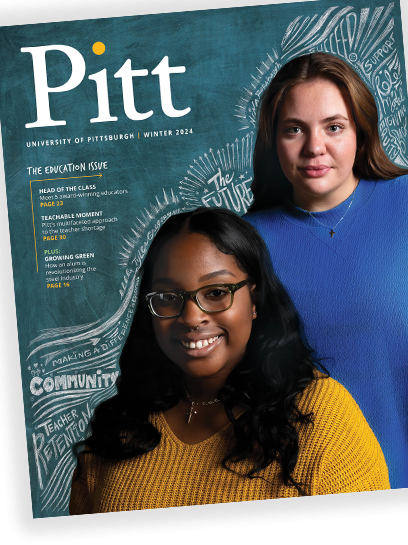
Subscribe to Pitt Magazine

Pitt researcher studies adolescent mental health, social media use and body image

Sophia Choukas-Bradley is submitting her first paper about adolescents and social media to a psychology journal. It’s 2014, the early days of online culture, before teens lived on likes and danced on TikTok, and before parents and experts worried too much about the consequences.
Perhaps it explains why Choukas-Bradley’s paper is so quickly rejected, and why the journal’s anonymous peer reviewers offer her such a chilly — and ultimately shortsighted — rebuke.
Why would we study things online when we already know what happens offline? This is just the same thing in a slightly different form.
“And now everyone laughs when I say that,” she says. “Because anyone who's a parent, and anyone who has been a teen during the years of modern social media, understands that this is fundamentally different.”
Choukas-Bradley, an assistant professor of psychology at Pitt, has spent over a decade studying interpersonal and sociocultural influences on adolescent mental health, with an emphasis on social media, body image and LGBTQ+ youth.
She’s coined terms that are now commonplace in the discipline, published nearly 80 papers and served on two American Psychological Association expert advisory panels to develop guidelines for adolescent social media use — the first of which influenced the 2023 Surgeon General’s report.
“I’m just really interested in how social media changes how we view ourselves,” she says.
It all began in middle school when Choukas-Bradley noticed how she and her friends turned from carefree kids to self-conscious teens, preoccupied with the way the world judged their bodies and behaviors. Years later, as a graduate student at the University of North Carolina, she observed how the ubiquity of smartphones and the always-on nature of social media turned up the volume on those already pulsing adolescent body image issues. She calls it “the perfect storm.”
Through her research at Pitt’s Teen and Young Adult (TAYA) lab , Choukas-Bradley has been able to show that teens’ constant worry about being judged by an online audience — known as appearance-related social media consciousness, or ASMC — not only magnifies body image concerns but can also manifest in disordered eating and depressive symptoms.
This phenomenon has become a focus of the TAYA lab, which Choukas-Bradley founded in 2017. Her team uses multiple methods — large-scale questionnaires, in-depth interviews and even eye-tracking devices that reveal what teens are looking at online (spoiler alert: they’re fixating on attractive images) — to better understand the dangers of social media and develop interventions to diminish its negative power.
Her research shows that disordered eating and depressive symptoms influenced by social media use are more pervasive among teens who identify as girls and LGBTQ+ youth and that simply warning teens of the danger isn’t enough.
Together with Brian Galla from Pitt’s School of Education, the Center for Digital Thriving at Harvard (where she serves as the clinical psychology lead) and Common Sense Media , Choukas-Bradley has created evolving intervention materials that show teens how big tech intentionally targets youth, manipulating images, information and — ultimately — their own views.
But Choukas-Bradley is quick to add that social media isn’t all bad. In fact, for most teens, it’s become a critically important part of interpersonal development. And, for many LGBTQ+ youth, particularly those who live in rural communities or who don’t have parental support, social media is a lifeline, providing connection and acceptance they may not receive in their physical communities.
Recently, Choukas-Bradley received a prestigious National Science Foundation CAREER Award , which will allow her to study 300 girls over 18 months using multiple research methods to better understand the breadth and depth of how teens experience their time online.
“I believe it's important not to figure out how we can get kids offline — I think social media is here to stay — but to figure out how to have the time spent online be more positive and values-aligned.”

An official website of the United States government
Here’s how you know
Official websites use .gov A .gov website belongs to an official government organization in the United States.
Secure .gov websites use HTTPS A lock ( Lock A locked padlock ) or https:// means you’ve safely connected to the .gov website. Share sensitive information only on official, secure websites.
Surgeon General Issues New Advisory About Effects Social Media Use Has on Youth Mental Health
Surgeon General Dr. Vivek Murthy Urges Action to Ensure Social Media Environments are Healthy and Safe, as Previously-Advised National Youth Mental Health Crisis Continues
Today, United States Surgeon General Dr. Vivek Murthy released a new Surgeon General’s Advisory on Social Media and Youth Mental Health . While social media may offer some benefits, there are ample indicators that social media can also pose a risk of harm to the mental health and well-being of children and adolescents. Social media use by young people is nearly universal, with up to 95% of young people ages 13-17 reporting using a social media platform and more than a third saying they use social media “almost constantly.”
With adolescence and childhood representing a critical stage in brain development that can make young people more vulnerable to harms from social media, the Surgeon General is issuing a call for urgent action by policymakers, technology companies, researchers, families, and young people alike to gain a better understanding of the full impact of social media use, maximize the benefits and minimize the harms of social media platforms, and create safer, healthier online environments to protect children. The Surgeon General’s Advisory is a part of the Department of Health and Human Services’ (HHS) ongoing efforts to support President Joe Biden’s whole-of-government strategy to transform mental health care for all Americans.
“The most common question parents ask me is, ‘is social media safe for my kids’. The answer is that we don't have enough evidence to say it's safe, and in fact, there is growing evidence that social media use is associated with harm to young people’s mental health,” said U.S. Surgeon General Dr. Vivek Murthy . “Children are exposed to harmful content on social media, ranging from violent and sexual content, to bullying and harassment. And for too many children, social media use is compromising their sleep and valuable in-person time with family and friends. We are in the middle of a national youth mental health crisis, and I am concerned that social media is an important driver of that crisis – one that we must urgently address.”
Usage of social media can become harmful depending on the amount of time children spend on the platforms, the type of content they consume or are otherwise exposed to, and the degree to which it disrupts activities that are essential for health like sleep and physical activity. Importantly, different children are affected by social media in different ways, including based on cultural, historical, and socio-economic factors. Among the benefits, adolescents report that social media helps them feel more accepted (58%), like they have people who can support them through tough times (67%), like they have a place to show their creative side (71%), and more connected to what’s going on in their friends’ lives (80%).
However, social media use can be excessive and problematic for some children. Recent research shows that adolescents who spend more than three hours per day on social media face double the risk of experiencing poor mental health outcomes, such as symptoms of depression and anxiety; yet one 2021 survey of teenagers found that, on average, they spend 3.5 hours a day on social media. Social media may also perpetuate body dissatisfaction, disordered eating behaviors, social comparison, and low self-esteem, especially among adolescent girls. One-third or more of girls aged 11-15 say they feel “addicted” to certain social media platforms and over half of teenagers report that it would be hard to give up social media. When asked about the impact of social media on their body image, 46% of adolescents aged 13-17 said social media makes them feel worse, 40% said it makes them feel neither better nor worse, and only 14% said it makes them feel better. Additionally, 64% of adolescents are “often” or “sometimes” exposed to hate-based content through social media. Studies have also shown a relationship between social media use and poor sleep quality, reduced sleep duration, sleep difficulties, and depression among youth.
While more research is needed to determine the full impact social media use has on nearly every teenager across the country, children and adolescents don’t have the luxury of waiting years until we know the full extent of social media’s effects. The Surgeon General’s Advisory offers recommendations stakeholders can take to help ensure children and their families have the information and tools necessary to make social media safer for children:
- Policymakers can take steps to strengthen safety standards and limit access in ways that make social media safer for children of all ages, better protect children’s privacy, support digital and media literacy, and fund additional research.
- Technology companies can better and more transparently assess the impact of their products on children, share data with independent researchers to increase our collective understanding of the impacts, make design and development decisions that prioritize safety and health – including protecting children’s privacy and better adhering to age minimums – and improve systems to provide effective and timely responses to complaints.
- Parents and caregivers can make plans in their households such as establishing tech-free zones that better foster in-person relationships, teach kids about responsible online behavior and model that behavior, and report problematic content and activity.
- Children and adolescents can adopt healthy practices like limiting time on platforms, blocking unwanted content, being careful about sharing personal information, and reaching out if they or a friend need help or see harassment or abuse on the platforms.
- Researchers can further prioritize social media and youth mental health research that can support the establishment of standards and evaluation of best practices to support children’s health.
In concert with the Surgeon General’s Advisory, leaders at six of the nation’s medical organizations have expressed their concern on social media’s effects on youth mental health:
“Social media can be a powerful tool for connection, but it can also lead to increased feelings of depression and anxiety – particularly among adolescents. Family physicians are often the first stop for parents and families concerned about the physical and emotional health of young people in their lives, and we confront the mental health crisis among youth every day. The American Academy of Family Physicians commends the Surgeon General for identifying this risk for America's youth and joins our colleagues across the health care community in equipping young people and their families with the resources necessary to live healthy, balanced lives.” – Tochi Iroku-Malize, M.D., MPH, MBA, FAAFP, President, American Academy of Family Physicians
“Today’s children and teens do not know a world without digital technology, but the digital world wasn’t built with children’s healthy mental development in mind. We need an approach to help children both on and offline that meets each child where they are while also working to make the digital spaces they inhabit safer and healthier. The Surgeon General’s Advisory calls for just that approach. The American Academy of Pediatrics looks forward to working with the Surgeon General and other federal leaders on Youth Mental Health and Social Media on this important work.” – Sandy Chung, M.D., FAAP, President, American Academy of Pediatrics
“With near universal social media use by America’s young people, these apps and sites introduce profound risk and mental health harms in ways we are only now beginning to fully understand. As physicians, we see firsthand the impact of social media, particularly during adolescence – a critical period of brain development. As we grapple with the growing, but still insufficient, research and evidence in this area, we applaud the Surgeon General for issuing this important Advisory to highlight this issue and enumerate concrete steps stakeholders can take to address concerns and protect the mental health and wellbeing of children and adolescents.We continue to believe in the positive benefits of social media, but we also urge safeguards and additional study of the positive and negative biological, psychological, and social effects of social media.”— Jack Resneck Jr., M.D., President, American Medical Association
“The first principle of health care is to do no harm – that’s the same standard we need to start holding social media platforms to. As the Surgeon General has pointed out throughout his tenure, we all have a role to play in addressing the youth mental health crisis that we now face as a nation. We have the responsibility to ensure social media keeps young people safe. And as this Surgeon General’s Advisory makes clear, we as physicians and healers have a responsibility to be part of the effort to do so.” – Saul Levin, M.D., M.P.A., CEO and Medical Director, American Psychiatric Association
“The American Psychological Association applauds the Surgeon General's Advisory on Social Media and Youth Mental Health, affirming the use of psychological science to reach clear-eyed recommendations that will help keep our youth safe online. Psychological research shows that young people mature at different rates, with some more vulnerable than others to the content and features on many social media platforms. We support the advisory's recommendations and pledge to work with the Surgeon General's Office to help build the healthy digital environment that our kids need and deserve.” – Arthur Evans, Jr., Ph.D., Chief Executive Officer and Executive Vice President, American Psychological Association.
“Social media use by young people is pervasive. It can help them, and all of us, live more connected lives – if, and only if, the appropriate oversight, regulation and guardrails are applied. Now is the moment for policymakers, companies and experts to come together and ensure social media is set up safety-first, to help young users grow and thrive. The Surgeon General’s Advisory about the effects of social media on youth mental health issued today lays out a roadmap for us to do so, and it’s critical that we undertake this collective effort with care and urgency to help today’s youth.” – Susan L. Polan, Ph.D., Associate Executive Director, Public Affairs and Advocacy, American Public Health Association
The National Parent Teacher Association shared the following:
“Every parent’s top priority for their child is for them to be happy, healthy and safe. We have heard from families who say they need and want information about using social media and devices. This Advisory from the Surgeon General confirms that family engagement on this topic is vital and continues to be one of the core solutions to keeping children safe online and supporting their mental health and well-being.” – Anna King, President of the National Parent Teacher Association .
In December 2021, Dr. Murthy issued a Surgeon General’s Advisory on Protecting Youth Mental Health calling attention to our national crisis of youth mental health and well-being. Earlier this month, he released a Surgeon General’s Advisory on Our Epidemic of Loneliness and Isolation , where he outlined the profound health consequences of social disconnection and laid out six pillars to increase connection across the country, one of which being the need to reform our digital environments. The new Surgeon General’s Advisory on Social Media and Youth Mental Health is a continuation of his work to enhance the mental health and well-being of young people across the country.
The full Surgeon General’s Advisory can be read here . For more information about the Office of the Surgeon General, visit www.surgeongeneral.gov/priorities .
Sign Up for Email Updates
Receive the latest updates from the Secretary, Blogs, and News Releases
Subscribe to RSS
Receive latest updates

Related News Releases
Biden-harris administration expands access to mental health and substance use services with addition of 10 new states to ccbhc medicaid demonstration program, readout of federal interagency working group on arts, health, and civic infrastructure meeting, hhs mental health accomplishments by the numbers, related blog posts.

The HHS Office for Civil Rights Celebrates National Recovery Month
Media inquiries.
For general media inquiries, please contact [email protected] .
An official website of the United States government
The .gov means it’s official. Federal government websites often end in .gov or .mil. Before sharing sensitive information, make sure you’re on a federal government site.
The site is secure. The https:// ensures that you are connecting to the official website and that any information you provide is encrypted and transmitted securely.
- Publications
- Account settings
Preview improvements coming to the PMC website in October 2024. Learn More or Try it out now .
- Advanced Search
- Journal List
- Int J Environ Res Public Health

Social Media Use and Body Dissatisfaction in Adolescents: The Moderating Role of Thin- and Muscular-Ideal Internalisation
An t. vuong.
1 College of Health and Biomedicine, Victoria University, Melbourne, VIC 8001, Australia; [email protected]
2 School of Psychology & Public Health, La Trobe University, Melbourne, VIC 3086, Australia; [email protected]
Hannah K. Jarman
Jo r. doley.
3 Institute for Health and Sport, Victoria University, Melbourne, VIC 8001, Australia; [email protected]
Siân A. McLean
Associated data.
Data are available from authors upon reasonable request.
Internalisation of appearance ideals moderates the relationship between exposure to media images and body dissatisfaction. To date, the role of thin- and muscular-ideal internalisation in the context of social media remains under explored, particularly for boys. As such, we aimed to explore how social media use (Instagram and Snapchat) was related to body dissatisfaction, and whether thin- and muscular-ideal internalisation would moderate this relationship in a sample of 1153 adolescent boys and girls (55.42% males; M age = 13.71, SD = 1.14). As hypothesised, social media use, and thin- and muscular ideal internalisation were positively correlated with body dissatisfaction in both genders. In moderation analyses, thin-ideal internalisation emerged as the only variable that had a significant effect on body dissatisfaction in both genders. Additionally, the influence of social media use on body dissatisfaction was moderated by muscular-ideal internalisation in boys, whereby for boys with high muscular-ideal internalisation, greater social media use was associated with greater body dissatisfaction. The two-way (muscular x thin-ideal internalisation) and three-way interaction (social media use x thin-ideal internalisation x muscular-ideal internalisation) effects on body dissatisfaction were non-significant. These findings emphasise the importance of considering the sociocultural environment (i.e., new media influences) as frameworks for understanding body dissatisfaction and suggest targeting of internalisation of appearance ideals in body dissatisfaction prevention programs.
1. Introduction
Body dissatisfaction, the negative self-evaluation of one’s appearance [ 1 ], is experienced across the lifespan, but adolescence is a period of particular vulnerability [ 2 ]. An emerging factor relevant to body dissatisfaction in adolescence is social media use, which has been found to predict increases in body dissatisfaction among girls and boys [ 3 ]. However, social media does not affect body dissatisfaction to the same degree in all young people and individual characteristics may affect the extent to which social media use is associated with body dissatisfaction. One such factor is the internalisation of appearance ideals that promote thinness in females and muscularity in males [ 4 , 5 ]. Emerging evidence suggests that mass media can be highly influential as it may lead adolescents to internalise Western societal ideals about physical attractiveness and beauty, resulting in dissatisfaction with their own appearance when they are unable to mirror these standards [ 6 , 7 ], yet this remains unexamined in the context of social media. Despite being active social media users as well as undergoing a critical period that puts them at greater risk for body dissatisfaction [ 8 , 9 ], there is presently a lack of research of this nature among adolescents. Therefore, this study aims to fill this gap by examining how social media use (Instagram and Snapchat) is related to adolescents’ body dissatisfaction, and whether thin- and muscular-ideal internalisation would moderate this relationship.
Adolescence is an important period for body dissatisfaction. Many adolescents are highly invested in their appearance and are vulnerable to the development of body image concerns [ 8 , 10 ]. Adolescents begin to demonstrate declines in body esteem (i.e., appearance and weight satisfaction) at 13 years of age [ 11 ] and this persists throughout mid-adolescence [ 12 , 13 ]. A high proportion of boys (50%) and girls (74%) at age 14 have been found to want to modify something about their body [ 14 ]. The prevalence of body dissatisfaction in adolescents is concerning given that it has been found to prospectively predict negative physical and psychological health outcomes such as depression, poor self-esteem, and eating disorders [ 2 , 15 ]. Body dissatisfaction has also been shown to predict engagement in risky body-change behaviours such as supplement use, excessive exercise, muscle-gaining strategies, and restrictive dieting practices among adolescents [ 16 , 17 ].
Although body dissatisfaction has been observed to be more normative and profound in adolescent girls compared to boys [ 18 , 19 ], new evidence suggests that it is becoming a considerable issue among both genders [ 20 , 21 ]. However, the nature of body dissatisfaction experienced by girls and by boys tends to differ in that concerns expressed by girls typically focus on attaining a thin appearance ideal, whereas boys’ appearance ideal tends to be lean and muscular [ 22 ]. Similarly, boys tend to place more value on their functional abilities (e.g., physical qualities and strength) whereas girls tend to be more invested in the aesthetic qualities of their outward appearance [ 23 ]. Thus, it follows that weight gain has been frequently reported as a body change strategy among adolescent boys while weight reduction strategies such as dieting are more common among adolescent girls [ 24 , 25 ]. As a result, external influences on body dissatisfaction and personal characteristics that may mitigate those influences could differ for boys and for girls, so more research is required to discern the factors that contribute to body dissatisfaction in both groups.
Sociocultural models of the development of body dissatisfaction and eating disorders, such as the tripartite influence model [ 26 ] and the dual pathway model [ 27 ] provide a framework to guide understanding of factors relevant to the development of body dissatisfaction. According to these models, appearance pressures that emanate from peers, family, and media (the latter being the focus of the present study) and psychological processes (e.g., appearance-ideal internalisation and social comparisons) contribute to the emergence and maintenance of body dissatisfaction. Subsequently, body dissatisfaction leads to risk factors for disordered eating (e.g., dieting and negative affect) and in turn, the onset of bulimic pathology. In relation to media, social media use is becoming highly relevant for young adolescents compared with traditional media, with Instagram and Snapchat used more frequently than other platforms [ 28 ]. Over the past decade, the total number of hours per day that early adolescents devoted to social media had risen and the percentage of those who used social media on a daily basis had almost doubled [ 29 ]. Therefore, investigating the influence of social media, rather than traditional media, on body dissatisfaction may be more reflective of the media environment in which adolescents are engaged.
Social media sites, particularly Instagram and Snapchat, allow opportunities for users to share and view visual content that can be digitally retouched to reflect beauty ideals [ 30 ]. Given that these platforms involve behaviours such as commenting and liking, adolescents can become fixated on how they present themselves and are enticed to post pictures that conform to appearance ideals in hopes of gaining approval from others [ 31 , 32 ]. Thus, the highly visual nature of social media stimuli means that adolescents are constantly exposed to unrealistic appearance ideals when engaging with peers and celebrities, which may heighten their body dissatisfaction levels [ 33 , 34 ]. As cultivation theory suggests [ 35 ], frequent engagement with social media content may prompt negative behaviours and attitudes about society’s ideal appearance due to regular and repeated exposure [ 31 , 34 ]. Empirical evidence supports this contention whereby positive relationships between social media use (especially highly visual platforms) and body dissatisfaction have been identified in pre to late adolescent boys and girls [ 36 , 37 ]. Interestingly, specific online behaviours (e.g., “likes” received and selfie-posting) had no significant impact on body dissatisfaction even when controlling for BMI and gender [ 37 ]. Thereby, narrowing the focus of general social media use to appearance-focused platforms seems appropriate [ 21 , 38 ]. Despite gender differences regarding social media behaviours (posting, commenting, and liking), boys are equally prolific users who are also subject to idealised imagery [ 28 , 39 ]. Social media use also heightens opportunities for boys to make appearance comparisons, subsequently increasing their levels of body dissatisfaction [ 40 ]. Notably, these recent observations stress that boys who use social media are just as vulnerable as girls to negative body image.
In addition, sociocultural models also specify a role for internalisation of appearance ideals, that is, the endorsement of and aspiration to achieve Western appearance standards (e.g., thinness in females and muscularity in males), in the transmission of sociocultural appearance pressures to body dissatisfaction. In this manner, individuals who internalise appearance ideals, such as those presented in social media, are more likely to experience body dissatisfaction when they find they cannot attain the typically unrealistic appearance ideals promoted by these sources [ 41 ]. Meta-analytic work has illustrated that media exposure reinforces appearance-ideal internalisation and this can affect both genders of all ages, although adolescents were the most at risk [ 42 ]. Similarly, the association between appearance-ideal internalisation and body dissatisfaction does not significantly differ across gender but the magnitude of this relationship was more profound in younger than older individuals [ 43 ]. Such findings allude to the importance of mixed-gender studies and research in adolescents who are most vulnerable, hence the focus of this study.
There are two ways internalisation has been conceptualised in the relationship between media exposure and body dissatisfaction; baseline trait internalisation as a moderator and change in trait internalisation as a mediator [ 5 ]. Recently, considerable research has examined internalisation as a mediator in adults [ 44 , 45 , 46 ] and adolescents [ 47 ] but fewer studies have examined internalisation as a moderator in the context of social media use. In this regard, internalisation (baseline) as a moderator will be the focus of this paper in that higher internalisation is expected to strengthen the negative influence of media imagery on body image and this detrimental effect is expected to diminish with lower internalisation levels [ 48 , 49 ].
As described, appearance ideals may reflect either the thin or muscular body type. Traditionally, thin-ideal internalisation has been examined in the domain of female body image and empirical findings have demonstrated well-established associations between these concepts among girls. For example, greater thin-ideal internalisation has been associated with greater body dissatisfaction in adolescent girls [ 7 , 50 ] and has also been recognised as a prospective predictor of body dissatisfaction among young adolescent girls [ 51 ]. Although thin-ideal internalisation could also be relevant to adolescent boys given research indicating that they desire to look lean with low body fat [ 52 , 53 ], research among boys is somewhat limited to date and findings are conflicting. Some studies found that thin-ideal internalisation did not predict body dissatisfaction in boys [ 54 , 55 ]. However, one study found that internalised thin ideals in the media increased men’s body dissatisfaction [ 56 ].
In parallel to thin-ideal internalisation, muscular-ideal internalisation has commonly been perceived as more relevant to males than females. This relevance is demonstrated in research findings among adolescent boys whereby those who highly internalised the muscular/athletic ideal were more dissatisfied with their bodies than those who did not [ 55 , 57 ]. There is also empirical support for muscular-ideal internalisation as a moderator between media exposure and body dissatisfaction. Boys who highly endorsed masculine gender roles regarding muscularity and strength were more vulnerable to negative mass media effects (magazines and advertisements) as inferred by their higher body-change desires and drives for muscularity [ 58 , 59 ].
Despite the traditional focus on males, research has also begun to explore muscular-ideal internalisation among females. Initial evidence suggested that muscular-ideal internalisation was not detrimental to women’s body image [ 60 ]. However, with the advent of social media movements such as ‘fitspiration’, whereby thin and toned images are accompanied by text that motivates acquisition of the fit ideal appearance, an unrealistically muscular appearance is now an element of the female appearance ideal [ 61 , 62 ]. Thus, muscular-ideal internalisation may be more relevant and potentially be associated with body image in both girls and boys. Emerging evidence has indicated that media exposure to muscular ideal imagery predicts greater body dissatisfaction and drives for both thinness and muscularity in females [ 55 , 63 ]. Furthermore, muscular-ideal internalisation has also been found to be positively associated with muscle building behaviours in boys and girls, indicating the relevance of this form of internalisation for adolescents regardless of gender [ 47 ]. In light of the changing social media environment promoting both thin and muscular ideals, further research examining both thin- and muscular-ideal internalisation may provide a more complete picture of the underlying mechanisms that shape body dissatisfaction in both girls and boys.
Taken together, much of the existing research on internalisation as a moderator has been confined to adult samples and revolves around typical appearance attributes (i.e., thin-ideal internalisation in females and muscular-ideal internalisation in males) [ 48 , 58 , 59 , 64 ]. Therefore, the overarching aim of the current study was to add to past research and explore the relationships between social media use (Instagram and Snapchat), thin-ideal internalisation, muscular-ideal internalisation, and body dissatisfaction in adolescents. In both girls and boys, it was hypothesised that (1) social media use, thin-ideal internalisation, and muscular-ideal internalisation would be positively associated with body dissatisfaction, and (2) thin- and muscular-ideal internalisation would individually moderate the relationship between social media use and body dissatisfaction. Specifically, a stronger association between social media use and body dissatisfaction would be demonstrated for those with high levels of internalisation compared to those with low levels. In exploratory moderation analyses, we aimed to test the effects of a 2-way interaction (between thin- and muscular-ideal internalisation) and a 3-way interaction (between thin-ideal internalisation, muscular-ideal internalisation, and social media use) on body dissatisfaction. No specific assumptions were formed for these exploratory aims.
2.1. Participants
The initial sample comprised 1200 adolescents from grades 7 to 10 in two independent, co-educational high schools in Melbourne, Australia, who were recruited to take part in a longitudinal study of body dissatisfaction and well-being in adolescence over 1-year. For the present study, data from the first wave of data collection were analysed. Inclusion criteria were that participants had a social media account or profile and identified as either male or female. Following exclusion, data from 1153 (males n = 665; females n = 488) participants were included in analyses ( n = 306, n = 266, n = 405, and n = 176 in grades 7, 8, 9, and 10, respectively). Participants’ ages ranged from 11 to 17 years ( M age = 13.71, SD = 1.14). Their BMI (kg/m 2 ) ranged from 11.02 to 57.81 ( M BMI = 19.89, SD = 3.68) and, in line with World Health Organization cut-offs for BMI-for-age z-scores [ 65 ], the BMI of the majority of participants was classified as ‘normal’ weight (80.22%), with 9.89% ‘overweight’, 8.27% ‘underweight’, and 1.62% ‘obese’. Most participants were born in Australian/New Zealand (83.5%), followed by Asia (9.2%), Europe (4.7%), and other (2.6%).
2.2. Measures
2.2.1. demographic information.
Participants were asked to indicate their age, gender, and country of birth.
2.2.2. Social Media Use
To assess social media use, respondents were asked to specify how often they used two appearance-related social media sites (Snapchat and Instagram) on a 5-point scale (1 = never to 5 = always ). A mean score was calculated, with higher scores indicating greater frequency of social media use. Another study used a similar approach to measure the frequency of social media use [ 66 ]. Use of Snapchat and Instagram were included in analyses due to high popularity amongst adolescents in western cultures, being highly image-centric, and having been associated with body image concerns [ 67 ].
2.2.3. Thin-Ideal Internalisation
The Thin/Low Body Fat subscale of the Sociocultural Attitudes Towards Appearance-4 Scale (SATAQ-4) was used to assess thin-ideal internalisation [ 68 ]. This measure assesses the degree to which individuals endorse or strive towards the thin body ideal. On a 5-point Likert scale (1 = definitely disagree to 5 = definitely agree ), participants rated how much they agreed with five items (e.g., “I want my body to look very lean (e.g., like celebrities and models)”). Mean scores were calculated with higher scores indicating greater thin-ideal internalisation. In this study, the internal consistency was high for boys (α = 0.89) and girls (α = 0.92).
2.2.4. Muscular-Ideal Internalisation
The Internalisation-Muscular subscale of the SATAQ-4 assessed muscular-ideal internalisation [ 69 ]. This subscale measures the extent to which individuals internalise or strive towards the muscular body ideal. On a 5-point Likert scale (1 = definitely disagree to 5 = definitely agree ), participants rated how strongly they agreed with four statements (e.g., “I think a lot about looking muscular (e.g., like sports stars and fitspiration posts)”). The mean score was calculated whereby higher scores indicate greater internalisation of the muscular body ideal. For this sample, the internal consistency was high for boys (α = 0.93) and girls (α = 0.93).
2.2.5. Body Dissatisfaction
The appearance subscale of the Body Esteem Scale for Adolescents and Adults (BESAA) was used as an index of body dissatisfaction [ 70 ]. Although it traditionally assesses an individual’s global appraisal of their outward appearance, it has been empirically linked to body dissatisfaction [ 71 ] and has been used as a broad indicator of body dissatisfaction elsewhere [ 72 , 73 ]. Participants were asked to indicate how true ten statements were for them on a 5-point scale (1 = never to 5 = always ). Example items include, “I wish I looked like someone else” and “I feel ashamed of how I look”. Positively-worded items (e.g., “I like what I look like in pictures”) were reverse scored. The mean score was calculated with higher scores indicating greater body dissatisfaction. For the current study, the internal consistency was high for boys (α = 0.88) and girls (α = 0.92).
2.3. Procedures
The study was approved by the university’s Human Ethics Committee (approval number: HED18424). Written informed consent procedures were implemented in which parents had the option to opt their child out of participation. Prior to the commencement of the survey, the research team gave verbal instructions and written informed active assent was obtained from all participants. Participants completed the online survey independently in classroom settings, supervised by researchers. The survey took approximately 30 min to complete and contained approximately 150 items. At the end of the questionnaire, students were invited to provide height and weight measurements. If students wished to provide their measurements, they could either provide an estimate, or use height and weight equipment which had been set up and facilitated in a private area by a member of the research team.
2.4. Data Analysis
SPSS 26 (IBM Corp: Armonk, NY, USA) and Mplus 8.0 (Muthen & Muthen: Los Angeles, CA, USA) were used for data analyses. Consistent with research in adolescents of a similar nature [ 67 ], missing data across each outcome variable was moderate (8–12%). Little’s missing completely at random (MCAR) test [ 74 ] indicated that the data were missing completely at random ( p > 0.05). Data were not normally distributed so non-parametric alternatives were used for preliminary analysis. Mann-Whitney U Tests were conducted to examine gender differences on study variables and Spearman correlations were performed to determine zero-order relationships between variables. Effect sizes were evaluated according to recommendations by Khalilzadeh and Tasci [ 75 ]. Preliminary frequency and descriptive analyses were also performed.
Moderated multiple regression analyses were run to test whether thin- and muscular-ideal internalisation moderated the relationship between social media use and body dissatisfaction. A Maximum Likelihood Robust estimator was used which adjusts the standard errors and chi-square statistic for non-normality [ 76 ]. Continuous two-way and three-way interaction terms were calculated using mean-centred variables and were included as predictors of body dissatisfaction. To interpret the moderating effects, simple slopes were then plotted for significant interactions for the relationship between the independent variable (social media use) and the dependent variable (body dissatisfaction) when the levels of the moderator variable (thin-ideal and/or muscular-ideal internalisation) was one standard deviation above and below the mean. Finally, the significance of the slopes was tested [ 77 ] which denotes the simple effect of social media use on body dissatisfaction at two levels (high and low) of thin- and muscular-ideal internalisation. All analyses were performed separately for girls and boys.
3.1. Descriptive Statistics
Descriptive statistics for all measures are reported in Table 1 . Both girls and boys reported moderate levels of social media use, thin- and muscular-ideal internalisation, and body dissatisfaction. However, girls reported significantly higher social media use, thin-ideal internalization, and body dissatisfaction, and lower muscular-ideal internalization than boys. The majority of participants used Instagram (90.89%) and Snapchat (90.72%). As shown in Figure 1 , both girls and boys predominantly used Instagram and Snapchat “often”. A low proportion of participants “never” or “rarely” used Instagram. Similarly, a low proportion of participants “rarely” used Snapchat.

Frequency of social media site use among adolescent girls and boys.
Means (M), Standard Deviations (SD) and Gender Differences in Social Media and Body Image Variables.
| Girls | Boys | Gender Differences | ||||
|---|---|---|---|---|---|---|
| M | SD | M | SD | -Value | Cohen’s d | |
| Social Media Use | 3.60 | 1.02 | 3.19 | 1.11 | <0.001 | 0.36 |
| Thin-Ideal Internalisation | 2.87 | 1.11 | 2.18 | 0.93 | <0.001 | 0.67 |
| Muscular-Ideal Internalisation | 2.17 | 1.00 | 2.82 | 1.11 | <0.001 | 0.59 |
| Body Dissatisfaction | 2.76 | 0.87 | 2.29 | 0.81 | <0.001 | 0.57 |
Note . Girls n = 488, boys n = 665.
3.2. Correlations
As shown in Table 2 , Spearman correlations indicated that social media use, thin-ideal internalisation, and muscular-ideal internalisation were positively and significantly correlated with body dissatisfaction. There were also positive correlations between social media use and thin- and muscular-ideal internalisation, except for the relationship between social media use and muscular-ideal internalisation in girls. In both girls and boys, correlations between all variables were small, apart from the large correlation between thin-ideal internalisation and body dissatisfaction in girls.
Spearman Correlations between Social Media Use, Thin-Ideal Internalisation, Muscular-Ideal Internalisation and Body Dissatisfaction, in Boys and Girls.
| Social Media Use | Thin-Ideal Internalisation | Muscular-Ideal Internalisation | Body Dissatisfaction | |
|---|---|---|---|---|
| Social Media Use | _ | 0.21 ** | 0.06 | 0.20 ** |
| Thin-ideal Internalisation | 0.13 ** | _ | 0.27 ** | 0.64 ** |
| Muscular-ideal Internalisation | 0.26 ** | 0.47 ** | _ | 0.19 ** |
| Body Dissatisfaction | 0.10 * | 0.24 ** | 0.14 ** | _ |
Note . Correlations above the diagonal line are for girls (n = 488). Correlations below the diagonal line are for boys (n = 665). * p < 0.05 (two-tailed), ** p < 0.01 (two-tailed).
3.3. Moderation Analyses
Moderated multiple regression analyses examined cross-sectional predictors of body dissatisfaction and tested whether thin- and muscular-ideal internalisation moderated the relationship between social media use and body dissatisfaction. For girls, there was a positive main effect of thin-ideal internalisation on body dissatisfaction (β = 0.600, p < 0.001) but there was no main effect of muscular-ideal internalisation on body dissatisfaction (β = 0.020, p = 0.642). There was also no main effect of social media use on body dissatisfaction (β = 0.054, p = 0.267). None of the interaction terms were significant (social media use x muscular-ideal internalisation: β = 0.001, p = 0.984; social media use x thin-ideal internalisation: β = −0.044, p = 0.385; muscular-ideal internalisation x thin-ideal internalisation: β = −0.017, p = 0.694; and social media use x thin-ideal internalisation x muscular-ideal internalisation: β = 0.015, p = 0.761).
For boys, thin-ideal internalisation had a positive main effect on body dissatisfaction (β = 0.240, p < 0.001) but there was no main effect of muscular-ideal internalisation on body dissatisfaction (β = −0.021, p = 0.707). There was also no main effect of social media use on body dissatisfaction (β = 0.037, p = 0.384). The interaction between social media use and muscular-ideal internalisation was positively associated with body dissatisfaction (β = 0.124, p = 0.006), however the interaction between social media use and thin-ideal internalisation was not significant (β = −0.020, p = 0.654), nor was the interaction between muscular- and thin-ideal internalisation (β = 0.018, p = 0.734). The three-way social media use x thin-ideal internalisation x muscular-ideal internalisation interaction was not significant and demonstrated a small effect among boys (β = 0.100, p = 0.055).
Simple slopes tests were conducted in boys to follow-up the significant interaction effect which revealed that muscular-ideal internalisation moderated the effect of social media use on body dissatisfaction for boys, such that a relationship between social media use and body dissatisfaction was evident only at high levels of muscular-ideal internalisation, but not low levels (see Figure 2 ). Specifically, for boys with high muscular-ideal internalisation, higher social media use was associated with greater body dissatisfaction (β = 0.116, p = 0.005). For boys with low muscular-ideal internalisation, there was no relationship between social media use and body dissatisfaction (β = −0.063, p = 0.202). These results provide partial support for our hypotheses.

The two-way interaction effect of muscular-ideal internalisation and social media use on body dissatisfaction in boys.
4. Discussion
The aim of the present study was to broaden current understandings of relationships between social media use, thin- and muscular-ideal internalisation, and body dissatisfaction. The first hypothesis, that appearance-related social media use would be positively and significantly associated with body dissatisfaction in girls and boys, was supported. This is consistent with previous findings in Western samples [ 36 , 67 ] and consolidates the small body of literature that has examined this relationship in boys [ 38 ]. Additionally, thin- and muscular-ideal internalisation were positively and significantly correlated with body dissatisfaction in girls and boys which is consistent with prior research [ 78 , 79 , 80 ]. As adolescents are now faced with the unhealthy standard of the ‘strong’ and ‘skinny’ paradox on social media [ 81 ], it is unsurprising that those who endorse such ideals also experience body dissatisfaction. Furthermore, these results underscore the importance of athletic-ideal internalisation, a novel construct that entails both muscularity and thinness [ 68 ], in the prediction of body concerns (regarding weight/shape and muscularity) in both males and females [ 55 ].
In the multiple regression models in girls, thin-ideal internalisation emerged as the only variable that was significantly associated with body dissatisfaction. This adds to the mounting evidence that thin–ideal internalisation is problematic for girls’ body image [ 50 , 57 , 82 , 83 ]. Unexpectedly, neither thin- or muscular-ideal internalisation moderated the relationship between social media use and body dissatisfaction among girls. This latter finding conflicts with literature that has highlighted a moderation effect through thin-ideal internalisation in women [ 48 , 64 ]. Given that these studies were conducted in relation to effects from traditional media and in older samples, moderation may perhaps be stronger under those circumstances rather than when tested in younger individuals in the social media environment. Nevertheless, the absence of muscular-ideal internalisation as a cross-sectional predictor of body dissatisfaction and moderation via muscular/athletic-ideal internalisation supports some work in women [ 60 , 84 , 85 ], so it is possible that internalising the muscular/athletic physique does not have as strong an effect on body dissatisfaction as thin-ideal internalisation. Further investigation is needed to clarify these mixed findings.
In the multiple regression models in boys, thin-ideal internalisation emerged as the only variable that had a positive main effect on body dissatisfaction. This is in line with previous findings where thin-ideal internalisation has been shown to be related to body dissatisfaction in boys, as well as girls [ 86 ]. It should be emphasised that the measure of thin-ideal internalisation used in this study reflects endorsement of both thinness and leanness that is espoused in males currently and may be more relevant than previous measures of thin-ideal internalization that did not reflect the leanness component [ 54 , 87 ]. Notably, muscular-ideal internalisation but not thin-ideal internalisation moderated the relationship between social media use and body dissatisfaction in boys which partially supports our hypotheses. This extends previous research with traditional forms of media which found that those who highly endorsed the muscular ideal were more negatively affected by mass media portrayals compared to those who did not highly endorse the muscular ideal [ 58 , 59 ]. The relevance of muscular-ideal internalisation reflects modern appearance trends on social media (e.g., fitspiration posts) that emphasise hyper-muscular ideals in males [ 88 ]. As such, it may be more important for boys in the current social media environment to look muscular rather than thin, which may explain the lack of moderation through thin-ideal internalisation. Based on the findings, it appears that the interaction between social media use and internalisation is highly relevant for body dissatisfaction. For example, one study found that the internalisation-body satisfaction relationship was conditional upon the use of photo-editing apps in young adult women [ 89 ]. Further investigation is required to provide a deeper understanding of these associations in adolescents particularly in relation to temporal sequencing.
Additionally, the two-way interaction (muscular x thin-ideal internalisation) was non-significant in effect on body dissatisfaction for both girls and boys. This is similar to past research in women and suggests that incorporating thinness into that of the muscular ideal (e.g., fit-ideal internalisation) does not alter body dissatisfaction levels [ 90 ]. As previously posited [ 90 ], moderation may not have occurred because thin- and muscular-ideal internalisation are only related to body image outcomes when analysed independently rather than concurrently. More research is warranted to support these claims. Likewise, the three-way interaction (social media use x thin- x muscular-ideal internalisation) was non-significant in both girls and boys. That is, body dissatisfaction scores did not vary across the levels of these factors in their interaction, they were equivalent regardless of the interaction between frequency of social media use and tendencies of thin- and muscular-ideal internalisation. Despite approaching significance in boys at the p < 0.05 level, the effect was small relative to the other effects in boys (e.g., comparison to beta coefficients for thin-ideal internalisation and the social media use x muscular-ideal internalisation interaction). These preliminary findings offer important avenues for future research to help elucidate the conditions and personal characteristics that elevate risk and could thus be targeted in interventions to prevent the detrimental impact of social media engagement on body dissatisfaction.
Despite the contributions of this study to our knowledge of the role of social media use and internalisations in explaining body dissatisfaction, there are several limitations. First, although our narrow focus on the use of appearance-related platforms (Instagram and Snapchat) was informed by previous findings [ 37 ], it fails to address relevant photo-based behaviours such as commenting, liking, and posting pictures that have been previously associated with body dissatisfaction [ 91 , 92 , 93 ]. Future research in this direction could be valuable. Second, causality cannot be established due to the cross-sectional nature of the study and thus, experimental and longitudinal studies are warranted to identify whether combinations of social media use and internalisation of appearance ideals constitute risk for body dissatisfaction. Although this study contributes to the growing field of body image research, inclusion of other potential risk factors in sociocultural models of body image concerns such as social comparisons may also serve as an important direction for future research [ 94 , 95 ]. Finally, considering the wide age range of adolescents in our study (11–17 years), future research could incorporate age as a potential moderator.
Given the relevance of muscular-ideal internalisation as a moderator, particularly in the case for boys, there is a need for prevention programs targeted towards adolescents who may be more sensitive to the negative effect of muscularity focused appearance-related media on body dissatisfaction. Similarly, boys engaged in muscularity-focused activities, such as sports, may benefit from such intervention. In particular, dissonance-based approaches have demonstrated effectiveness in minimising appearance-ideal internalisation and body dissatisfaction levels [ 96 , 97 ]. Furthermore, media-literacy programs offering education on forming critical arguments against unrealistic body ideal images in the media have demonstrated some benefits [ 49 ].
5. Conclusions
Findings from this study build upon existing research on the positive relationships between social media use and body dissatisfaction, and between thin- and muscular-ideal internalisation and body dissatisfaction in adolescent boys and girls. This underscores the importance of mixed gender studies and extends the literature to adolescents. These findings also support consideration of the sociocultural environment as a framework for understanding body dissatisfaction in the new media environment and emphasise the importance of thin-ideal internalisation as a significant cross-sectional predictor of body dissatisfaction in both genders. Additionally, muscular-ideal internalisation moderated the relationship between social media use and body dissatisfaction in boys highlighting the centrality of muscularity to boys’ body dissatisfaction. Results suggest the need to focus on relevant concerns for boys and girls and support the use of intervention and prevention efforts that aim to lessen appearance-ideal internalisation, thereby reducing the detrimental effects of appearance-related media exposure on body dissatisfaction.
Author Contributions
Authors A.T.V., S.A.M. and H.K.J. contributed to the study conception and design. Formal analysis and investigation were performed by A.T.V. and H.K.J. with contribution from S.A.M. and J.R.D. The original draft was written by A.T.V. All authors have read and agreed to the published version of the manuscript.
This research received no external funding.
Institutional Review Board Statement
The study was approved by the institutional ethics committee (Approval number: HED18424).
Informed Consent Statement
Written, informed, opt-out parental consent and active participant assent was obtained.
Data Availability Statement
Conflicts of interest.
The authors declare no conflict of interest.
Publisher’s Note: MDPI stays neutral with regard to jurisdictional claims in published maps and institutional affiliations.
Deal with a Bully and Overcome Bullying
Body dysmorphic disorder (bdd), eating disorder treatment and recovery, caffeine and its effects on teenagers, dealing with revenge porn and “sextortion”.
- Cyberbullying: Dealing with Online Bullies
Help for Parents of Troubled Teens
- Vaping: The Health Risks and How to Quit
- Online Therapy: Is it Right for You?
- Mental Health
- Health & Wellness
- Children & Family
- Relationships
Are you or someone you know in crisis?
- Bipolar Disorder
Eating Disorders
- Grief & Loss
- Personality Disorders
- PTSD & Trauma
- Schizophrenia
- Therapy & Medication
- Exercise & Fitness
- Healthy Eating
- Well-being & Happiness
- Weight Loss
- Work & Career
- Illness & Disability
- Heart Health
- Childhood Issues
- Learning Disabilities
- Family Caregiving
- Teen Issues
- Communication
- Emotional Intelligence
- Love & Friendship
- Domestic Abuse
- Healthy Aging
- Aging Issues
- Alzheimer’s Disease & Dementia
- Senior Housing
- End of Life
- Meet Our Team
What is body shaming?
Causes of body shaming, effects of body shaming, how to turn body shaming into body positivity, turn body shaming into body positivity tip 1: cultivate self-love, tip 2: replace negative self-talk, tip 3: manage time spent on social media, tip 4: make friends with food, tip 5: reach out to someone you trust, how to help a loved one with body shaming, body shaming: the effects and how to overcome it.
Hearing negative comments about your appearance can impact your body image and leave you feeling anxious and self-conscious. But there are ways to manage fat shaming or other critical comments, and achieve body acceptance.
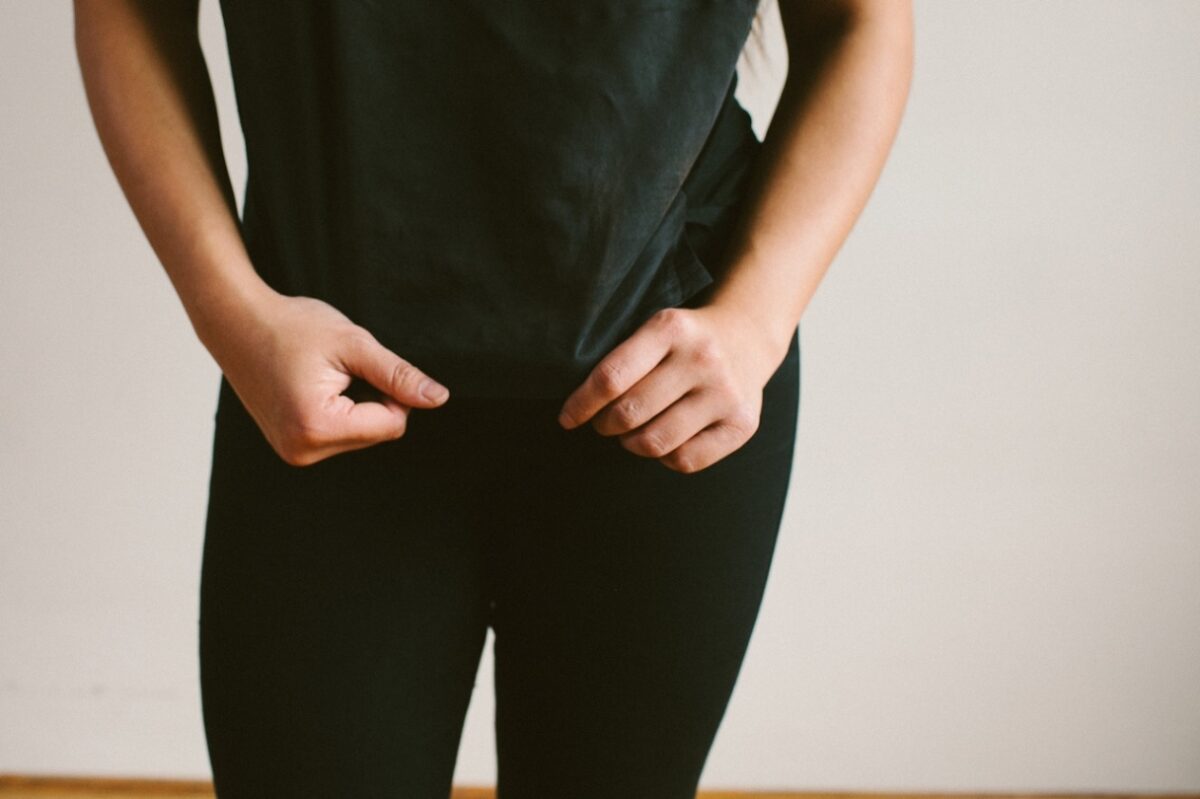
Body shaming involves humiliating someone by making inappropriate or negative comments about their body size or shape. As well as “fat shaming,” you may also hear negative comments if you’re underweight or in reference to a specific body part.
This type of criticism can be made to others or yourself. You may feel unhappy with your weight or how your body looks and judge yourself harshly. You may even engage in negative self-talk, such as “I feel so fat today” or “I need to stop stuffing my face with food.”
The act of body shaming can be carried out in person or remotely via the internet and social media and can be done by your parents, siblings, friends, or people you’re not even close to.
Even in a joking manner, remarks about what you eat or how much food you consume constitutes body shaming. Giving someone advice about dieting or praising weight loss is also considered body shaming, whether intentional or not. Often, your friends and family members don’t want to hurt your feelings, but their comments can still be of a critical nature. They may not realize the negative effect that questions like “Have you lost weight?” or “Do you really need to eat all of that?” can have.
While nobody is immune to societal pressures to look a certain way, comments about your body are unnecessary in any context. Whether the body shaming is being done by yourself or others, there are ways to overcome the problem, build body positivity, and learn to look at yourself in a more compassionate and realistic way.
Social media and body shaming
Social media often emphasizes physical appearance and makes it easy to post hurtful comments about others. The overall message is often that you should strive for the perfect body and find ways to hide your flaws. This can have a huge influence on your body image.
Body shaming on digital platforms is related to cyberbullying, but there are ways to fight back against those who body shame online, overcome the pain and anguish they cause, and reclaim your sense of self-worth.
See Cyberbullying: Dealing with Online Bullies .
Our “selfie” culture emphasizes outward beauty and we’re constantly bombarded with images of glamourous celebrities in magazines, advertisements, TV shows, and other types of media.
What you see every day on TikTok, Facebook, and Instagram can understandably make you feel envious of others or focus your thinking on your physical appearance and any perceived flaws. You may struggle to live up to these standards and experience negative feelings and judgements about yourself. This can become destructive when it diminishes your self-worth and body image.
A fixation with how you look can create unrealistic expectations that are impossible to achieve. Even when you know that these idealized images are digitally altered or enhanced, it’s easy to fall into the trap of unfavorably comparing yourself—or others.
Speak to a Licensed Therapist
BetterHelp is an online therapy service that matches you to licensed, accredited therapists who can help with depression, anxiety, relationships, and more. Take the assessment and get matched with a therapist in as little as 48 hours.
Body shaming in teens
Adolescents are particularly vulnerable to body shaming, weight shaming, and appearance-based shaming. In the teen years, your attitudes and beliefs about body image and self-esteem are largely influenced by your family members, peers, and social media. Mothers can often be role models for their daughters, for example. If your mother is continually complaining about her own shape or weight, or pointing out problems in how you look or eat, it’s bound to have an impact on how you view yourself.
As you develop during adolescence, it’s normal to be highly sensitive to comments about body shape, weight, and appearance. Weight-related bullying during adolescence contributes to negative body perceptions and preoccupations with specific body parts. Adolescents who are overweight are particularly vulnerable, and this can often lead to depression .
You might think that only teenage girls are the victims of body shaming, but boys can also be affected. They may be particularly concerned about not being muscular enough in relationship to the popular concept of masculinity.
Even supermodels and prima ballerinas have insecurities and imperfections, but we still tend to perceive them to be the ultimate representations of beauty. If you don’t measure up to these standards, you may feel inadequate and unworthy. And if you experience body shaming by others and take their negative comments to heart, it can lead to unhealthy behaviors and mental health problems, such as:
Having a negative body image is one of the main factors for developing disordered eating or an eating disorder , such as anorexia, bulimia, or binge eating.
You may start a diet that involves restrictive eating in an attempt to change your body shape or size. But such dieting can spiral into harmful behaviors like skipping meals, fasting, vomiting after eating, excessive exercising, or overusing laxatives. Over time, you end up depriving your body and brain of essential nutrients that are necessary for optimal health.
Body shaming comments such as “Did you lose weight? You look so much better,” can be triggering and create more disordered eating habits in an attempt to maintain or lose even more weight.
Experiencing body-shaming can interfere with your self-image and make you feel extremely self-conscious. This can escalate into body dysmorphic disorder , where you become obsessed with a perceived appearance flaw that can create repeated avoidance behaviors.
Your daily life can become consumed with concerns about a small flaw, or one that is not apparent to others. You may constantly look at yourself in the mirror or avoid mirrors altogether, conceal body parts you don’t like, pick at your skin, or frequently ask others if you look okay.
If you are constantly ashamed of your body, it can also impair your performance at school and interfere with your relationships with peers, teachers, and family members. Fears about being judged by others may cause you to limit or avoid social activities.
[Read: Body Dysmorphic Disorder (BDD)]
Severe symptoms of BDD can result in you dropping out of school because you’re unable to cope with the constant level of distress. You may even develop depression or suicidal thoughts and behaviors .
Excessive Exercising
Being physically active is normally one of the best things you can do for your health and well-being. However, if it becomes an addiction and you engage in compulsive exercising, it can lead to persistent fatigue, injuries, and susceptibility to illness or trigger anxiety, depression, or irritability.
If you are exercising compulsively, you may also start to withdraw from social situations as exercise becomes your main focus. Excessive exercising can progress into a syndrome called Relative Energy Deficiency in Sport (RED-S) which occurs when your calorie intake is not sufficient for the amount of energy you are expending to maintain healthy functioning.
Anxiety and depression
Body shaming can trigger or worsen existing symptoms of anxiety and depression. If you are body-shamed in public or on social media, you may try to avoid going to school or other situations where this shaming might occur. You may withdraw from others and feel isolated and alone .
Hearing critical comments about your appearance can also be humiliating, heighten your insecurities, and damage your self-esteem. Consequently, you may engage in negative self-talk as you internalize these feelings of worthlessness. You may tell yourself things like “I am a bad person” or “I am completely worthless.” This can escalate into extreme loneliness, depression, anxiety, and poor body image.
Physical Health Issues
Fat shaming, in particular, is rampant in our society as obesity is associated with being lazy, unattractive, and lacking willpower to lose weight. In one study, over 70% of adolescents reported being bullied about their weight in the past few years. This can be harmful to your physical as well as psychological health.
Rather than being a motivating factor for losing weight , fat shaming actually has the opposite effect. The stress has been linked to a reduction in physical activity and the consumption of more calories.
[Read: Childhood Obesity and Weight Problems]
Being the target of weight bias and discrimination can also affect your metabolism, lead to further weight gain, and increase your chances of becoming obese. This in turn can elevate the risk factors for high blood pressure , high cholesterol, heart disease, type-2 diabetes, and other physical health problems.
In recent years, there has been an effort to reverse the body shaming emphasis and promote more love and acceptance of how we look. Social media platforms have utilized body positivity hashtags to gain more followers and help address the appearance-based prejudices that have been ingrained in us.
Of course, it will take time to change longstanding ideals of beauty. We have all internalized these messages in different ways based upon our cultural beliefs and norms. As the saying goes, “Beauty is in the eye of the beholder,” and this also holds true for our views about various body shapes and sizes.
How to build body positivity
Body positivity is a continuous journey towards accepting yourself and others. It takes patience and practice to alter longstanding cultural beliefs and learn self-compassion. You can’t control what others say or do, but you can change your all-or-nothing thinking and start to view yourself as a whole person.
Following these basic steps can help you overcome body shaming and build body positivity:
- Cultivate self-love.
- Replace negative self-talk.
- Manage your time spent on social media.
- Make friends with food.
- Reach out to someone you trust for guidance and support.
The first steps to protecting yourself from body shaming are to stop body-shaming yourself and develop self-compassion. Remember that your health status takes priority over your physical appearance, and that should always be your primary concern.
Don’t hide or isolate yourself from others . We all have days when we don’t look or feel our best, but don’t let this destroy your self-esteem or sense of worth. Take a step back and think about the critical inner dialog you are imposing on yourself. Is this really an accurate representation of who you are? Say “no” to yourself when you’re looking in the mirror and feeling disgust for your face or your body.
Treat yourself with kindness and understanding , as you would a best friend. Taking care of yourself is not a selfish act; it’s necessary for your personal well-being. Exercise, eat healthy food, enjoy the company of people who care about you, and spend some time outdoors to refresh your body and your mind.
Manage stress . Experiencing body shaming can be extremely stressful. Relaxation techniques such as exercise, meditation, and deep breathing exercises are all good ways to build resilience and prevent you from feeling overwhelmed by negative experiences.
[Read: Stress Management]
Embrace the power of your body . Our bodies serve us well on a daily basis to function effectively and keep us healthy. Rather than being upset about your appearance, express gratitude for this “sacred vessel” you inhabit. Take notice of simple things you often take for granted, such as breathing, blood pumping to the heart, and your miraculous senses. The most important thing you can do is strive for a healthy body, which is separate from your feelings about your weight and desire for perfection.
While you can’t control what others say about you, you do have the power to focus on the positive aspects of yourself, rather than dwelling on any perceived flaws. Learning to accept your own imperfections will ultimately free you from placing unfair judgments on yourself or others.
Replacing negative self-talk with positive thoughts and affirmations can be useful for making you feel better about yourself and your body.
Shift your focus to the things that you like about yourself . For example, if you have beautiful hair or eyes, this is just as important as the features you dislike or that others try to ridicule. The next time you look in the mirror, notice these positive attributes.
Instead of repeating negative messages, accept yourself without criticism . You can tell yourself: “I accept my body just as it is,” or “My body is strong and healthy.”
Be proud of your individuality . Your value as a human being is worth much more than your physical body. Remembering the positive qualities that you bring to the world is the foundation for attaining body acceptance.
Start off with body neutrality . If you’re not quite ready to embrace body positivity, work towards having body neutrality. That means you are accepting and respectful of your body, without having to either love or hate it. When you practice body neutrality, you place the emphasis on what your body can do, rather than what your body looks like. For example, you can remind yourself: “My legs enable me to walk and run long distances.”
Don’t body shame others
Research shows that when you promote body positivity to others, you also feel more positively about your own body. Surround yourself with people who are courteous and treat others with respect. Avoid bullies who engage in body shaming and talk about the flaws of others.
Establish boundaries with your circle of friends and make it clear that you will not tolerate comments about your body or weight. You can also set an example by standing up for others who are the targets of body shaming.
Spending too much time on social media can add to your anxiety, loneliness, and body dissatisfaction, reinforce unrealistic expectations of yourself, and expose you to body shaming and cyberbullying.
[Read: Social Media and Mental Health]
If you reduce your time on social media, you will be able to participate in other activities that elevate your mood and tap into your creative potential. Try:
Connecting to others in-person . Cutting down or stepping away from social media can give you an opportunity to connect in-person and improve the quality of your social interactions. Communicating face-to-face is nature’s antidote to stress and can be a lot more rewarding than texting or messaging.
Physical activities like walking, running, swimming, dancing, and other fun sports. Being active is important for your overall health and well-being and can help increase your confidence, self-esteem, and sense of accomplishment.
Practicing mindfulness through yoga, meditation, deep breathing, or journaling.
If you are shamed or ashamed about your weight, it’s easy to develop an unhealthy attitude towards food. Mindful eating can help you remember that food is not the enemy and whatever your weight, you can still find enjoyment in eating.
To make friends with food and eat more mindfully:
- Tune out all distractions while you’re eating, such as phones, TV, and other types of multitasking in order to enrich this pleasant experience.
- By concentrating on the present moment and accepting your thoughts and feelings, you can savor each bite, eat slowly, and respond to your body’s needs.
- Planning nutritious meals ahead of time or trying out new recipes are other great ways to make friends with food.
You may feel embarrassed about confiding in someone about the body shaming you’re experiencing, but there’s no reason you have to handle this on your own. Reach out to others for guidance and support and let them know what you have been experiencing.
It’s crucial to find someone you trust and feel comfortable sharing your feelings with. Having a safe outlet to express your emotions can help you cope with the distress and humiliation of being body shamed.
If you need additional assistance in the recovery process, don’t hesitate to schedule an appointment with a licensed mental health counselor or therapist. They can offer unbiased advice to help you feel more empowered and heal from the effects of body shaming.
If a friend or loved one is being body shamed by others, your compassion and understanding can be invaluable.
Let them know you are concerned and how much you care about them. You can say, “I feel worried that you are always talking about your weight,” or “I feel sad when you speak negatively about your appearance.”
Be patient and listen to their concerns . Don’t assume that you know what your loved one needs, but rather ask how you can best support them. They may just want a shoulder to cry on, someone to listen to their worries without judgment.
Try to shift the focus away from your loved one’s body to something else you admire about them. For example, you can remind them about their wonderful sense of humor, how smart they are, their adventurous spirit, or highlight a particular talent they have.
If your child has been body shamed
It can be extremely hurtful to learn that your child or teenager has been body shamed. But like any bullying or cyberbullying behavior, there are steps you can take to deal with the problem—or even help prevent it before it starts.
Educate your child about body shaming . Let them know that people can sometimes be cruel to each other and how your child should value and respect both themselves and others. Remind them that body shaming in any form is unacceptable.
Talk to your child’s teachers or school administrators if the problem is occurring at school.
Encourage your child to seek new friends if their current ones are engaging in body shaming. Enrolling in sports teams, youth clubs, and after-school activities are great ways for your child to expand their social circle.
Be a good role model . Speak positively about your own body and catch yourself if you say something negative about your own appearance. Try to use body-positive or body-neutral language to set a healthy example.
Reduce the time your child spends on social media . Be aware of what your child is posting and reading about on social media platforms. The more you know about your child’s life online, the sooner you’ll be able to identify and address any body shaming issues.
Reassure your child . Let your child know that you love them unconditionally for both their inner and outer beauty. Refrain from criticizing or teasing a child or teenager about their appearance, even in jest.
Encourage a healthy lifestyle that nurtures your child’s body—but keep the subjects of appearance, weight, and dieting out of the discussion. Focus instead on what your child’s body is capable of. Remind them how well their body serves to help them run, jump, draw, play a musical instrument, or solve puzzles.
Bolster your child’s self-esteem and resilience through exercise and creative endeavors. Having them involved in team sports, volunteer organizations, or group activities can help build self-confidence and improve social skills. Physical activity can also help to relieve anxiety and stress and boost your child’s mood.
Helplines and support
Bullying helplines.
1-800-273-8255 – Crisis Call Center
0845 22 55 787 – National Bullying Helpline
1-877-352-4497 – BullyingCanada
1800 551 800 – Kids Helpline
1098 – Childline India
Eating disorder helplines
National Eating Disorders Association or call 1-800-931-2237 (National Eating Disorders Association)
Beat Eating Disorders or call 0345 643 1414 (Helpfinder)
Butterfly Foundation for Eating Disorders or call 1800 33 4673 (National Eating Disorders Collaboration)
Service Provider Directory or call 1-866-633-4220 (NEDIC)
More Information
- What’s the Difference Between Body Positivity and Body Neutrality? - Embracing both can be healthy. (Cleveland Clinic)
- 8 steps to mindful eating - Change the way you think about food. (Harvard Health Publishingc)
- Words Have Weight: The Many Forms of Body-Shaming - A closer look at body-shaming towards ourselves and others. (Psychology Today)
- Body Image and Self-Esteem - You don’t need a perfect body to have a good body image. (TeensHealth)
- Encouraging a Healthy Body Image - Tips for parents. (KidsHealth)
- Feeding and Eating Disorders. (2013) In Diagnostic and Statistical Manual of Mental Disorders . American Psychiatric Association. Link
- Obsessive-Compulsive and Related Disorders. (2013). In Diagnostic and Statistical Manual of Mental Disorders . American Psychiatric Association. Link
- Gam, Rahul, Shivendra Singh, Manish Manar, Sujita Kar, and Abhishek Gupta. “Body Shaming among School-Going Adolescents: Prevalence and Predictors.” International Journal Of Community Medicine And Public Health 7 (March 14, 2020). Link
- Schlüter, Constanze, Gerda Kraag, and Jennifer Schmidt. “Body Shaming: An Exploratory Study on Its Definition and Classification.” International Journal of Bullying Prevention , November 9, 2021. Link
- Voelker, Dana K, Justine J Reel, and Christy Greenleaf. “Weight Status and Body Image Perceptions in Adolescents: Current Perspectives.” Adolescent Health, Medicine and Therapeutics 6 (August 25, 2015): 149–58. Link
- Weingarden, Hilary, Keith D. Renshaw, Eliza Davidson, and Sabine Wilhelm. “Relative Relationships of General Shame and Body Shame with Body Dysmorphic Phenomenology and Psychosocial Outcomes.” Journal of Obsessive-Compulsive and Related Disorders 14 (July 2017): 1–6. Link
- BDD. “Suicidality in BDD.” Accessed June 13, 2022. Link
- “RED-S | Boston Children’s Hospital.” Accessed June 13, 2022. Link
- Vogel, Lauren. “Fat Shaming Is Making People Sicker and Heavier.” CMAJ : Canadian Medical Association Journal 191, no. 23 (June 10, 2019): E649. Link
- Clark, Olivia, Matthew M. Lee, Muksha Luxmi Jingree, Erin O’Dwyer, Yiyang Yue, Abrania Marrero, Martha Tamez, Shilpa N. Bhupathiraju, and Josiemer Mattei. “Weight Stigma and Social Media: Evidence and Public Health Solutions.” Frontiers in Nutrition 8 (2021). Link
- “Fat Shaming Linked to Greater Health Risks – Penn Medicine.” Accessed June 13, 2022. Link
- Zhang, D., Lee, E. K. P., Mak, E. C. W., Ho, C. Y., & Wong, S. Y. S. (2021). Mindfulness-based interventions: An overall review. British Medical Bulletin , 138(1), 41–57. Link
- Gelsinger, Ayla. “A Critical Analysis of the Body Positive Movement on Instagram: How Does It Really Impact Body Image?” Spectra Undergraduate Research Journal 1, no. 1 (February 26, 2021). Link
- Alleva, Jessica M., Melissa M. Medoch, Kira Priestley, Johanna L. Philippi, Jolien Hamaekers, Eva N. Salvino, Sanne Humblet, and Marieke Custers. “‘I Appreciate Your Body, Because…’ Does Promoting Positive Body Image to a Friend Affect One’s Own Positive Body Image?” Body Image 36 (March 1, 2021): 134–38. Link
- Cohen, Rachel, Lauren Irwin, Toby Newton-John, and Amy Slater. “#bodypositivity: A Content Analysis of Body Positive Accounts on Instagram.” Body Image 29 (June 2019): 47–57. Link
- Mendo-Lázaro, Santiago, Benito León-del-Barco, María-Isabel Polo-del-Río, Rocío Yuste-Tosina, and Víctor-María López-Ramos. “The Role of Parental Acceptance–Rejection in Emotional Instability During Adolescence.” International Journal of Environmental Research and Public Health 16, no. 7 (April 2019): 1194. Link
More in Teen Issues
How to protect yourself or your child

Always focusing on your physical flaws? You may have BDD.

How to overcome your eating disorder and gain true self-confidence

How much is safe and how to cut back
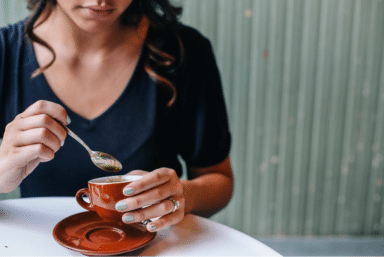
Coping with online abuse and practicing safe sexting

Cyberbullying
Protect yourself or your child online

Dealing with anger, violence, delinquency, and other behaviors

The health risks in young people and how to quit

Professional therapy, done online
BetterHelp makes starting therapy easy. Take the assessment and get matched with a professional, licensed therapist.
Help us help others
Millions of readers rely on HelpGuide.org for free, evidence-based resources to understand and navigate mental health challenges. Please donate today to help us save, support, and change lives.
How to Create a Social Media Marketing Strategy in 9 Easy Steps [Free Template]
Creating your social media marketing strategy doesn’t need to be painful. Create an effective plan for your business in 9 simple steps.

A social media marketing strategy is a summary of everything you plan to do and hope to achieve on social media. It guides your actions and lets you know whether you’re succeeding or failing.
The more specific your plan is, the more effective it will be. Keep it concise. Don’t make it so lofty and broad that it’s unattainable or impossible to measure.
In this post, we’ll walk you through a nine-step plan to create a winning social media strategy of your own. We’ve even got expert insights from Amanda Wood, Hootsuite’s Senior Manager of Social Marketing.
How to create a social media strategy:
Bonus: Get a free social media strategy template to quickly and easily plan your own strategy. Also use it to track results and present the plan to your boss, teammates, and clients.
What is a social media marketing strategy?
A social media strategy is a document outlining your social media goals, the tactics you will use to achieve them and the metrics you will track to measure your progress.
Your social media marketing strategy should also list all of your existing and planned social media accounts along with goals specific to each platform you’re active on. These goals should align with your business’s larger digital marketing strategy.
Finally, a good social media plan should define the roles and responsibilities within your team and outline your reporting cadence.

Create. Schedule. Publish. Engage. Measure. Win.
Creating your own social media marketing strategy (video guide)
No time to read the whole article? Let Amanda, Hootsuite’s own Senior Manager of Social Media Marketing, guide you through our free social media marketing strategy template in less than 10 minutes:

How to create a social media marketing strategy in 9 steps
Step 1. choose goals that align to business objectives, set s.m.a.r.t. goals.
The first step to creating a winning social media strategy is to establish clear objectives and goals. Without goals, you have no way to measure success and return on investment (ROI) .
Each of your social media marketing goals should be SMART : s pecific, m easurable, a ttainable, r elevant and t ime-bound.
Psst: Need help getting started? We’ve got social strategy guides for small businesses , financial services , government , higher education , healthcare , real estate , law firms , and non-profits .
Oh, and if you need examples of smart social media goals , we’ve got you covered there too.

Once you’ve decided on your goals, track them in a social media strategy doc — grab our free template if you don’t have one already.
Track meaningful metrics
Vanity metrics like number of followers and likes are easy to track, but it’s hard to prove their real value. Instead, focus on things like engagement, click-through, and conversion rates.
For inspiration, take a look at these 19 essential social media metrics .
You may want to track different goals for different social media networks, or even different uses for each network.
For example, if you use LinkedIn to drive traffic to your website, you would measure click-throughs. If Instagram is for brand awareness, you might track the number of Instagram Story views. And if you advertise on Facebook, cost-per-click (CPC) is a common success metric.
Social media goals should align with your overall marketing objectives. This makes it easier to show the value of your work and secure buy-in from your boss.

Start developing a successful social media marketing plan by writing down at least three goals for social media.
“ It’s easy to get overwhelmed by deciding what to post and which metrics to track, but you need to focus on what you want to get out of social media to begin with,” says Amanda Wood, Hootsuite’s Senior Manager of Social Marketing. “Don’t just start posting and tracking everything: match your goals to your business, and your metrics to your goals.”
Step 2. Learn everything you can about your audience
Get to know your fans, followers, and customers as real people with real wants and needs, and you will know how to target and engage them on social media.
When it comes to your ideal customer, you should know things like:
- Average income
- Typical job title or industry
Here’s a simple guide and template for creating audience/buyer personas .

Don’t forget to document this information in your strategy doc!
Social media analytics can also provide a ton of valuable information about who your followers are, where they live, and how they interact with your brand on social media. These insights allow you to refine your strategy and better target your audience.
Jugnoo, an Uber-like service for auto-rickshaws in India, used Facebook Analytics to learn that 90% of their users who referred other customers were between 18- and 34-years-old, and 65% of that group was using Android. They used that information to target their ads, resulting in a 40% lower cost per referral.
Check out our guide to using social media analytics and the tools you need to track them .
Step 3. Get to know your competition
Odds are your competitors are already using social media, and that means you can learn from what they’re doing.
Conduct a competitive analysis
A competitive analysis allows you to understand who the competition is and what they’re doing well (and not so well). You’ll get a good sense of what’s expected in your industry, which will help you set social media targets of your own.
It will also help you spot opportunities and weaknesses you can document in your social strategy doc.

Maybe one of your competitors is dominant on Facebook, for example, but has put little effort into X (Twitter) or Instagram. You might want to focus on the social media platforms where your audience is underserved, rather than trying to win fans away from a dominant player.
Use social media listening
Social listening is another way to keep an eye on your competitors.
Do searches of the competition’s company name, account handles, and other relevant keywords on social media. Find out what they’re sharing and what other people are saying about them. If they’re using influencer marketing, how much engagement do those campaigns earn them?
Pro tip : Use Hootsuite Streams to monitor relevant keywords, hashtags and accounts in real-time.
Try Hootsuite for free. You can cancel anytime.
As you track, you may notice shifts in how your competitors and industry leaders are using social media. You may come across new, exciting trends. You might even spot specific social content or a campaign that really hits the mark—or totally bombs.
Use this kind of intel to optimize and inform your own social media marketing strategy.
Just don’t go overboard on the spy tactics, Amanda advises. “ Make sure you aren’t ALWAYS comparing yourself to the competition — it can be a distraction. I’d say checking in on a monthly basis is healthy. Otherwise, focus on your own strategy and results.”
Step 4. Do a social media audit
If you’re already using social media, take stock of your efforts so far. Ask yourself the following questions:
- What’s working, and what’s not?
- Who is engaging with you?
- What are your most valuable partnerships?
- Which networks does your target audience use?
- How does your social media presence compare to the competition?
Once you collect that information, you’ll be ready to start thinking about ways to improve.
We’ve created an easy-to-follow social media audit guide and template to walk you through each step of this process.

Your audit should give you a clear picture of what purpose each of your social accounts serves. If the purpose of an account isn’t clear, think about whether it’s worth keeping.
To help you decide, ask yourself the following questions:
- Is my audience here?
- If so, how are they using this platform?
- Can I use this account to help achieve my goals?
Asking these tough questions will keep your social media strategy focused.
Look for impostor accounts
During the audit, you may discover fake accounts using your business name or the names of your products.
These imposters can be harmful to your brand—never mind that they’re capturing followers that should be yours.
You may want to get your accounts verified too to ensure your fans know they are dealing with the real you.
Here’s how to get verified on:
- X (Twitter)
Step 5. Set up accounts and improve profiles
Decide which networks to use.
As you decide which social networks to use, you will also need to define your strategy for each.
Benefit Cosmetics’ social media manager, Angela Purcaro, told eMarketer : “For our makeup tutorials … we’re all about Snapchat and Instagram Stories. [X], on the other hand, is designated for customer service.”
Hootsuite’s own social team even designates different purposes for formats within networks. On Instagram, for example, they use the feed to post high-quality educational infographics and product announcements and Stories to cover live events or quick social media updates.
View this post on Instagram A post shared by Hootsuite 🦉 (@hootsuite)
Pro tip : Write out a mission statement for each network. A one-sentence declaration to keep you focused on a specific goal.
Example: “We will use X for customer support to keep email and call volumes down.”
Or: “We will use LinkedIn for promoting and sharing our company culture to help with recruitment and employee advocacy.”
One more: “We will use Instagram to highlight new products and repost quality content from influencers.”
If you can’t create a solid mission statement for a particular social media channel, you may want to ask yourself if it’s worth it.
Note : While larger businesses can and do tackle every platform, small businesses may not be able to — and that’s ok! Prioritize social platforms that will have the most impact on your business and make sure your marketing team has the resources to handle content for those networks. If you need help focusing your efforts, check out our 18-minute social media plan .
Set up your profiles
Once you’ve decided which networks to focus on, it’s time to create your profiles. Or improve existing ones so they align with your strategy.
- Make sure you fill out all profile fields
- Include keywords people would use to search for your business
- Use consistent branding (logos, images, etc.) across networks so your profiles are easily recognizable
Pro tip : Use high-quality images that follow the recommended dimensions for each network. Check out our always-up-to-date social media image size cheat sheet for quick reference.
We’ve also got step-by-step guides for each network to walk you through the process:
- Create a Facebook business page
- Create an Instagram business account
- Create a TikTok account
- Create a X (Twitter) business account
- Create a Snapchat account
- Create a LinkedIn Company Page
- Create a Pinterest business account
- Create a YouTube channel
Don’t let this list overwhelm you. Remember, it’s better to use fewer channels well than to stretch yourself thin trying to maintain a presence on every network.
Optimize your profiles (and content) for search
Never heard of social SEO ? It’s time to learn.
44% of Gen Z consumers use social platforms to research their purchase decisions, which means it’s extra critical that your channels are optimized for social search.
That means making sure your profile names are clear and descriptive, you’re including relevant hashtags and keywords in your bio and on every post, and you’re using features like alt text and captions to include your target keywords as naturally as possible.
Step 6. Find inspiration
While it’s important that your brand be unique, you can still draw inspiration from other businesses that are great on social.
“ I consider it my job to stay active on social: to know what’s trending, which campaigns are winning, what’s new with the platforms, who’s going above and beyond,” says Amanda. “This might be the most fun step for you, or the hardest one, but it’s just as crucial as the rest of them.”
Social media success stories
You can usually find these on the business section of the social network’s website. ( Here’s Facebook’s , for example.)
Case studies can offer valuable insights that you can apply to your own social media plan.
Award-winning accounts and campaigns
You could also check out the winners of The Facebook Awards or The Shorty Awards for examples of brands that are at the top of their social media game.
For learning and a laugh, check out Fridge-Worthy, Hootsuite’s bi-weekly awards show highlighting brands doing smart and clever things on social media.
Your favorite brands on social media
Who do you enjoy following on social media? What do they do that compels people to engage and share their content?
National Geographic, for example, is one of the best on Instagram, combining stunning visuals with compelling captions.
View this post on Instagram A post shared by National Geographic (@natgeo)
Then there’s Shopify. The ecommerce brand uses Facebook to sell themselves by showcasing customer stories and case studies.
And Lush Cosmetics is a great example of superior customer service on X. They use their 280 characters to answer questions and solve problems in an extremely charming and on-brand way.

Source: lushcosmetics on X
Notice that each of these accounts has a consistent voice, tone, and style. That’s key to letting people know what to expect from your feed. That is, why should they follow you? What’s in it for them?
Consistency also helps keep your content on-brand even if you have multiple people on your social media team.
For more on this, read our guide on establishing a compelling brand voice on social media .
Ask your followers
Consumers can also offer social media inspiration.
What are your target customers talking about online? What can you learn about their wants and needs?
If you have existing social channels, you could also ask your followers what they want from you. Just make sure that you follow through and deliver what they ask for.
Step 7. Create a social media content calendar
Sharing great content is essential, of course, but it’s equally important to have a plan in place for when you’ll share content to get the maximum impact.
Your social media content calendar also needs to account for the time you spend interacting with the audience (although you need to allow for some spontaneous engagement as well).
Set your posting schedule
Your social media content calendar lists the dates and times at which you will publish types of content on each channel. It’s the perfect place to plan all of your social media activities—from images, link sharing, and re-shares of user-generated content to blog posts and videos. It includes both your day-to-day posting and content for social media campaigns.
Your calendar also ensures your posts are spaced out appropriately and published at the best times to post .
Pro tip: You can plan your whole content calendar and get recommended best times to post on every network based on your past engagement rate, impressions, or link click data in Hootsuite.

Hootsuite’s Best Time to Publish feature
Determine the right content mix
Make sure your content strategy and calendar reflect the mission statement you’ve assigned to each social profile, so that everything you post is working to support your business goals.
(We know, it’s tempting to jump on every meme, but there should always be a strategy behind your social media marketing efforts!)
You might decide that:
- 50% of content will drive traffic back to your website
- 25% of content will be curated from other sources
- 20% of content will support lead-generation goals (newsletter sign-ups, ebook downloads, etc.)
- 5% of content will be about your company culture
Placing these different post types in your content calendar will ensure you maintain the right mix.
If you’re starting from scratch and you’re not sure what types of content to post, try the 80-20 rule :
- 80% of your posts should inform, educate, or entertain your audience
- 20% can directly promote your brand.

You could also try the social media content marketing rule of thirds :
- One-third of your content promotes your business, converts readers, and generates profit.
- One-third of your content shares ideas and stories from thought leaders in your industry or like-minded businesses.
- One-third of your content is personal interactions with your audience

Whatever you decide on, be sure to document it in your strategy doc.

Don’t post too much or too little
If you’re starting a social media marketing strategy from scratch, you may not have figured out how often to post to each network for maximum engagement yet.
Post too frequently and you risk annoying your audience. But, if you post too little, you risk looking like you’re not worth following.
Start with these posting frequency recommendations:
- Instagram (feed): 3-7 times per week
- TikTok: 3-5 times per week
- Facebook: 1-2 times per day
- X (Twitter): 1-5 times per day
- LinkedIn: 1-5 times per day

Pro tip : Once you have your social media content calendar planned out, use a scheduling tool to prepare messages in advance rather than updating constantly throughout the day.
We might be biased, but we think Hootsuite is the best social media management tool. You can schedule social media posts to every network and the intuitive calendar view gives you a full picture of all your social activity each week.
Try It Free
Step 8. Create compelling content
Remember those mission statements you created for each channel in Step 5? Well, it’s time to go a bit deeper, a.k.a. provide some examples of the type of content you’ll post to fulfill your mission on each network.
If you’re not sure what to post, here’s a long list of social media content ideas to get you started. Or (to make it even easier) you can use an AI tool like OwlyWriter to generate on-brand content in a flash.
The idea here is to:
- Keep your content aligned with the purpose of each network;
- Show other stakeholders (if applicable) what kind of content they can expect to see on each network.
This last point especially will help you avoid any tension when your colleagues want to know why you haven’t posted their case study/whitepaper/blog post to TikTok yet. It’s not in the strategy, Linda!
Ideally, you will generate content types that are both suited to the network and the purpose you’ve set out for that network.
For example, you wouldn’t want to waste time posting brand awareness tweets if you’ve designated X/Twitter for primarily customer support. And you wouldn’t want to post super polished corporate video ads to TikTok, as users expect to see short, unpolished videos on that platform.
It might take some testing over time to figure out which type of content works best on which type of network, so prepare to update this section frequently.
We won’t lie: content creation isn’t as easy as everyone not on the social team seems to think. But if you’re struggling, Amanda suggests going back to basics.
The first question to ask is: is there cohesion between your content types? Is your content providing value? Do you have a good mix of entertaining, or educational content? What does it offer that makes a person stop and spend time? Creating a few different content pillars or categories that encompass different aspects of storytelling for your brand, and what you can offer your audience is a good start.
This brings us to Step 9.
Step 9. Track performance and make adjustments
Your social media marketing strategy is a hugely important document for your business, and you can’t assume you’ll get it exactly right on the first try.
As you start to implement your plan and track your results, you may find that some strategies don’t work as well as you’d anticipated, while others are working even better than expected.
That’s why it’s important to document your progress along the way.

Look at performance metrics
In addition to the analytics within each social network (see Step 2), you can use UTM parameters to track social visitors as they move through your website, so you can see exactly which social posts drive the most traffic to your website.
Benchmark your results
You’ve got your numbers, but how do they stack up to the competition in your industry? Industry benchmarks are a great way to evaluate your performance against other businesses in your category.
If you’ve got Hootsuite Analytics , you can use our built-in social media benchmarking tool to compare the performance of your social accounts against the average of brands in your industry with just a couple of clicks.
You can set up custom timeframes, switch between networks — Instagram, Facebook, X (Twitter), LinkedIn, and TikTok — and look up benchmarks for metrics like followers, audience growth rate, engagement rate, clicks, shares, and much more.
You’ll also find resources to improve your performance right in the summary section:

Re-evaluate, test, and do it all again
Once this data starts coming in, use it to re-evaluate your strategy regularly. You can also use this information to test different posts, social marketing campaigns, and strategies against one another. Constant testing allows you to understand what works and what doesn’t, so you can refine your social media marketing strategy in real time.
You’ll want to check the performance of all your channels at least once a week and get to know the basics of social media reporting so you can track your growth over time.
Pro tip: If you use Hootsuite, you can review the performance of all your posts on every network in one place. Once you get the hang of checking your analytics, you may even want to customize different reports to show specific metrics over a variety of different time periods.
Surveys can also be a great way to find out how well your social media strategy is working. Ask your followers, email list, and website visitors whether you’re meeting their needs and expectations, and what they’d like to see more of. Then make sure to deliver on what they tell you.
Finalizing your social media strategy
Spoiler alert: nothing is final.
Social media moves fast. New networks emerge, others go through demographic shifts.
Your business will go through periods of change as well.
All of this means that your social media marketing strategy should be a living document that you review and adjust as needed. Refer to it often to stay on track, but don’t be afraid to make changes so that it better reflects new goals, tools, or plans.
When you update your social strategy, make sure to watch our 5-step video on how to updating your social media strategy for 2024:
Social media strategy template
Ready to start documenting? Grab your free social media strategy template below!

What’s next? When you’re ready to put your plan into action, we’re here to help…
Save time managing your social media marketing strategy with Hootsuite. From a single dashboard you can easily:
- Plan, create, and schedule posts to every network
- Track relevant keywords, topics, and accounts
- Stay on top of engagement with a universal inbox
- Get easy-to-understand performance reports and improve your strategy as needed
Try Hootsuite for Free
With files from Shannon Tien .
Do it better with Hootsuite , the all-in-one social media tool. Stay on top of things, grow, and beat the competition.
Become a better social marketer.
Get expert social media advice delivered straight to your inbox.
Christina Newberry is an award-winning writer and editor whose greatest passions include food, travel, urban gardening, and the Oxford comma—not necessarily in that order.
Amanda Wood is a senior social marketing professional who combines analytical and creative thinking to build brands.
As head of social at Hootsuite, Amanda oversees the global social strategy encompassing organic and paid social on Instagram, Facebook, Twitter, TikTok, and LinkedIn, a social engagement and listening strategy, and an employee advocacy program.
As the leader of a high-performing social team, she has extensive experience collaborating with creatives to bring campaigns to life on social and drive business results.
Related Articles

How To Set and Exceed Social Media Goals [9 Examples]
Struggling with structuring your efforts on social? Set yourself up for success with our guide to setting and achieving smarter social media goals.

How to Run the Easiest Social Media Audit [FREE TEMPLATE]
A social media audit is the best way to review and improve any social marketing strategy. Check in on your efforts with this free template.

How to Create a Social Media Calendar and Stay Organized
Social media content calendars are the best way to plan and organize your content. Build one in 4 easy steps or use our free templates.

Social Media Marketing Tools: The Complete Guide
Automate your work, save time, and build better relationships with your audience by using the right social media marketing tools.
Numbers, Facts and Trends Shaping Your World
Read our research on:
Full Topic List
Regions & Countries
- Publications
- Our Methods
- Short Reads
- Tools & Resources
Read Our Research On:
Table of Contents
Which social media platforms are most common, who uses each social media platform, find out more, social media fact sheet.
Many Americans use social media to connect with one another, engage with news content, share information and entertain themselves. Explore the patterns and trends shaping the social media landscape.
To better understand Americans’ social media use, Pew Research Center surveyed 5,733 U.S. adults from May 19 to Sept. 5, 2023. Ipsos conducted this National Public Opinion Reference Survey (NPORS) for the Center using address-based sampling and a multimode protocol that included both web and mail. This way nearly all U.S. adults have a chance of selection. The survey is weighted to be representative of the U.S. adult population by gender, race and ethnicity, education and other categories.
Polls from 2000 to 2021 were conducted via phone. For more on this mode shift, read our Q&A.
Here are the questions used for this analysis , along with responses, and its methodology .
A note on terminology: Our May-September 2023 survey was already in the field when Twitter changed its name to “X.” The terms Twitter and X are both used in this report to refer to the same platform.

YouTube and Facebook are the most-widely used online platforms. About half of U.S. adults say they use Instagram, and smaller shares use sites or apps such as TikTok, LinkedIn, Twitter (X) and BeReal.
| Year | YouTube | TikTok | Snapchat | Twitter (X) | BeReal | Nextdoor | ||||||
|---|---|---|---|---|---|---|---|---|---|---|---|---|
| 8/5/2012 | 54% | 9% | 10% | 16% | 13% | |||||||
| 8/7/2012 | 14% | |||||||||||
| 12/9/2012 | 11% | 13% | 13% | |||||||||
| 12/16/2012 | 57% | |||||||||||
| 5/19/2013 | 15% | |||||||||||
| 7/14/2013 | 16% | |||||||||||
| 9/16/2013 | 57% | 14% | 17% | 17% | 14% | |||||||
| 9/30/2013 | 16% | |||||||||||
| 1/26/2014 | 16% | |||||||||||
| 9/21/2014 | 58% | 21% | 22% | 23% | 19% | |||||||
| 4/12/2015 | 62% | 24% | 26% | 22% | 20% | |||||||
| 4/4/2016 | 68% | 28% | 26% | 25% | 21% | |||||||
| 1/10/2018 | 73% | 68% | 35% | 29% | 25% | 22% | 27% | 24% | ||||
| 2/7/2019 | 73% | 69% | 37% | 28% | 27% | 20% | 24% | 22% | 11% | |||
| 2/8/2021 | 81% | 69% | 40% | 31% | 21% | 28% | 23% | 25% | 23% | 18% | 13% | |
| 9/5/2023 | 83% | 68% | 47% | 35% | 33% | 30% | 29% | 27% | 22% | 22% | 3% |
Note: The vertical line indicates a change in mode. Polls from 2012-2021 were conducted via phone. In 2023, the poll was conducted via web and mail. For more details on this shift, please read our Q&A . Refer to the topline for more information on how question wording varied over the years. Pre-2018 data is not available for YouTube, Snapchat or WhatsApp; pre-2019 data is not available for Reddit; pre-2021 data is not available for TikTok; pre-2023 data is not available for BeReal. Respondents who did not give an answer are not shown.
Source: Surveys of U.S. adults conducted 2012-2023.

Usage of the major online platforms varies by factors such as age, gender and level of formal education.
% of U.S. adults who say they ever use __ by …
- RACE & ETHNICITY
- POLITICAL AFFILIATION
| Ages 18-29 | 30-49 | 50-64 | 65+ | |
|---|---|---|---|---|
| 67 | 75 | 69 | 58 | |
| 78 | 59 | 35 | 15 | |
| 32 | 40 | 31 | 12 | |
| Twitter (X) | 42 | 27 | 17 | 6 |
| 45 | 40 | 33 | 21 | |
| Snapchat | 65 | 30 | 13 | 4 |
| YouTube | 93 | 92 | 83 | 60 |
| 32 | 38 | 29 | 16 | |
| 44 | 31 | 11 | 3 | |
| TikTok | 62 | 39 | 24 | 10 |
| BeReal | 12 | 3 | 1 | <1 |
| Men | Women | |
|---|---|---|
| 59 | 76 | |
| 39 | 54 | |
| 31 | 29 | |
| Twitter (X) | 26 | 19 |
| 19 | 50 | |
| Snapchat | 21 | 32 |
| YouTube | 82 | 83 |
| 27 | 31 | |
| 27 | 17 | |
| TikTok | 25 | 40 |
| BeReal | 2 | 5 |
| White | Black | Hispanic | Asian* | |
|---|---|---|---|---|
| 69 | 64 | 66 | 67 | |
| 43 | 46 | 58 | 57 | |
| 30 | 29 | 23 | 45 | |
| Twitter (X) | 20 | 23 | 25 | 37 |
| 36 | 28 | 32 | 30 | |
| Snapchat | 25 | 25 | 35 | 25 |
| YouTube | 81 | 82 | 86 | 93 |
| 20 | 31 | 54 | 51 | |
| 21 | 14 | 23 | 36 | |
| TikTok | 28 | 39 | 49 | 29 |
| BeReal | 3 | 1 | 4 | 9 |
| Less than $30,000 | $30,000- $69,999 | $70,000- $99,999 | $100,000+ | |
|---|---|---|---|---|
| 63 | 70 | 74 | 68 | |
| 37 | 46 | 49 | 54 | |
| 13 | 19 | 34 | 53 | |
| Twitter (X) | 18 | 21 | 20 | 29 |
| 27 | 34 | 35 | 41 | |
| Snapchat | 27 | 30 | 26 | 25 |
| YouTube | 73 | 83 | 86 | 89 |
| 26 | 26 | 33 | 34 | |
| 12 | 23 | 22 | 30 | |
| TikTok | 36 | 37 | 34 | 27 |
| BeReal | 3 | 3 | 3 | 5 |
| High school or less | Some college | College graduate+ | |
|---|---|---|---|
| 63 | 71 | 70 | |
| 37 | 50 | 55 | |
| 10 | 28 | 53 | |
| Twitter (X) | 15 | 24 | 29 |
| 26 | 42 | 38 | |
| Snapchat | 26 | 32 | 23 |
| YouTube | 74 | 85 | 89 |
| 25 | 23 | 39 | |
| 14 | 23 | 30 | |
| TikTok | 35 | 38 | 26 |
| BeReal | 3 | 4 | 4 |
| Urban | Suburban | Rural | |
|---|---|---|---|
| 66 | 68 | 70 | |
| 53 | 49 | 38 | |
| 31 | 36 | 18 | |
| Twitter (X) | 25 | 26 | 13 |
| 31 | 36 | 36 | |
| Snapchat | 29 | 26 | 27 |
| YouTube | 85 | 85 | 77 |
| 38 | 30 | 20 | |
| 29 | 24 | 14 | |
| TikTok | 36 | 31 | 33 |
| BeReal | 4 | 4 | 2 |
| Rep/Lean Rep | Dem/Lean Dem | |
|---|---|---|
| 70 | 67 | |
| 43 | 53 | |
| 29 | 34 | |
| Twitter (X) | 20 | 26 |
| 35 | 35 | |
| Snapchat | 27 | 28 |
| YouTube | 82 | 84 |
| 25 | 33 | |
| 20 | 25 | |
| TikTok | 30 | 36 |
| BeReal | 4 | 4 |

This fact sheet was compiled by Research Assistant Olivia Sidoti , with help from Research Analyst Risa Gelles-Watnick , Research Analyst Michelle Faverio , Digital Producer Sara Atske , Associate Information Graphics Designer Kaitlyn Radde and Temporary Researcher Eugenie Park .
Follow these links for more in-depth analysis of the impact of social media on American life.
- Americans’ Social Media Use Jan. 31, 2024
- Americans’ Use of Mobile Technology and Home Broadband Jan. 31 2024
- Q&A: How and why we’re changing the way we study tech adoption Jan. 31, 2024
Find more reports and blog posts related to internet and technology .
1615 L St. NW, Suite 800 Washington, DC 20036 USA (+1) 202-419-4300 | Main (+1) 202-857-8562 | Fax (+1) 202-419-4372 | Media Inquiries
Research Topics
- Email Newsletters
ABOUT PEW RESEARCH CENTER Pew Research Center is a nonpartisan fact tank that informs the public about the issues, attitudes and trends shaping the world. It conducts public opinion polling, demographic research, media content analysis and other empirical social science research. Pew Research Center does not take policy positions. It is a subsidiary of The Pew Charitable Trusts .
© 2024 Pew Research Center
Purdue Online Writing Lab Purdue OWL® College of Liberal Arts
Welcome to the Purdue Online Writing Lab

Welcome to the Purdue OWL
This page is brought to you by the OWL at Purdue University. When printing this page, you must include the entire legal notice.
Copyright ©1995-2018 by The Writing Lab & The OWL at Purdue and Purdue University. All rights reserved. This material may not be published, reproduced, broadcast, rewritten, or redistributed without permission. Use of this site constitutes acceptance of our terms and conditions of fair use.
The Online Writing Lab (the Purdue OWL) at Purdue University houses writing resources and instructional material, and we provide these as a free service at Purdue. Students, members of the community, and users worldwide will find information to assist with many writing projects. Teachers and trainers may use this material for in-class and out-of-class instruction.
The On-Campus and Online versions of Purdue OWL assist clients in their development as writers—no matter what their skill level—with on-campus consultations, online participation, and community engagement. The Purdue OWL serves the Purdue West Lafayette and Indianapolis campuses and coordinates with local literacy initiatives. The Purdue OWL offers global support through online reference materials and services.
Social Media
Facebook twitter.
Create designs that inspire
Trending searches, productivity, social media, generate stunning ai-powered visuals.

A girl rides a skateboard while walking her dog. The girl is wearing a purple sweatshirt, baggy jeans and boots. She has expressive, round brown eyes and a look of determination. The background is an out of focus park and the girl is in a 3d illustrated animation style.

A watercolor hummingbird, centered, in red and yellow with a soft cream, watercolor background.

A banana with sunglasses surfing a blue wave.

Front-facing view of a mountain with floral decorative elements, papercraft quilling style, in pastel pink, blue and purple colors.

An abstract background of melting liquid with a metallic sheen, dark purple and gold colors with reflective studio light.

Illustration of a man playing a decorated steel pan drum.

A macro, detailed portrait of the face of a Dalmatian dog staring straight ahead with bright blue eyes on a solid pastel blue, out of focus background. The portrait is realistic with studio lighting.

A yellow sun with orange rays rises over white and purple clouds in a pop art style. There should be a halftone effect and screen printing aesthetic. The orange rays radiate outward and fill the background.

A group of assorted donuts in a pink bakery box.

A portrait of a man in a digital collage style. The man is wearing thick red glasses with circular patterns in blue and orange on the inside of the frames. The man is in a red polka dot shirt with a background of thick, brightly colored lines in pink, blue, and red. Collaged into the background is a ferris wheel and a circus tent.

A profile view of a caterpillar crawling on a moss-covered rock with the lush, green forest in the background, macro view, detail, close-up.

Cartoon style woman with a blue hat, fishing on a river near a forest.

A colorful street scene in the style of Mexican mural art. The street has adobe-colored shops on both sides with striped awnings. There is a fountain in the center and trees and mountains in the distance.

A single pink ranunculus in the style of a vintage botanical drawing.

A unicorn stands on a wooden pier looking out over clouds below, with a starry night sky above.
Create and edit in an instant with Microsoft Designer

Image generator
Generate any image you can imagine with just a text description.

Background remover
Remove the background from your image in one click.

Sticker creator
Describe the sticker you want, and our AI will generate it for you.
Browse thousands of customizable templates
Fresh picks.

Celebrate an occasion

Food and drink

How it works

1. Start with the perfect template

2. Customize it with help from AI
See the templates for:

3. Share your creation with the world
Got any suggestions?
We want to hear from you! Send us a message and help improve Slidesgo
Top searches
Trending searches

classical music
29 templates

islamic history
37 templates

27 templates

31 templates

17 templates
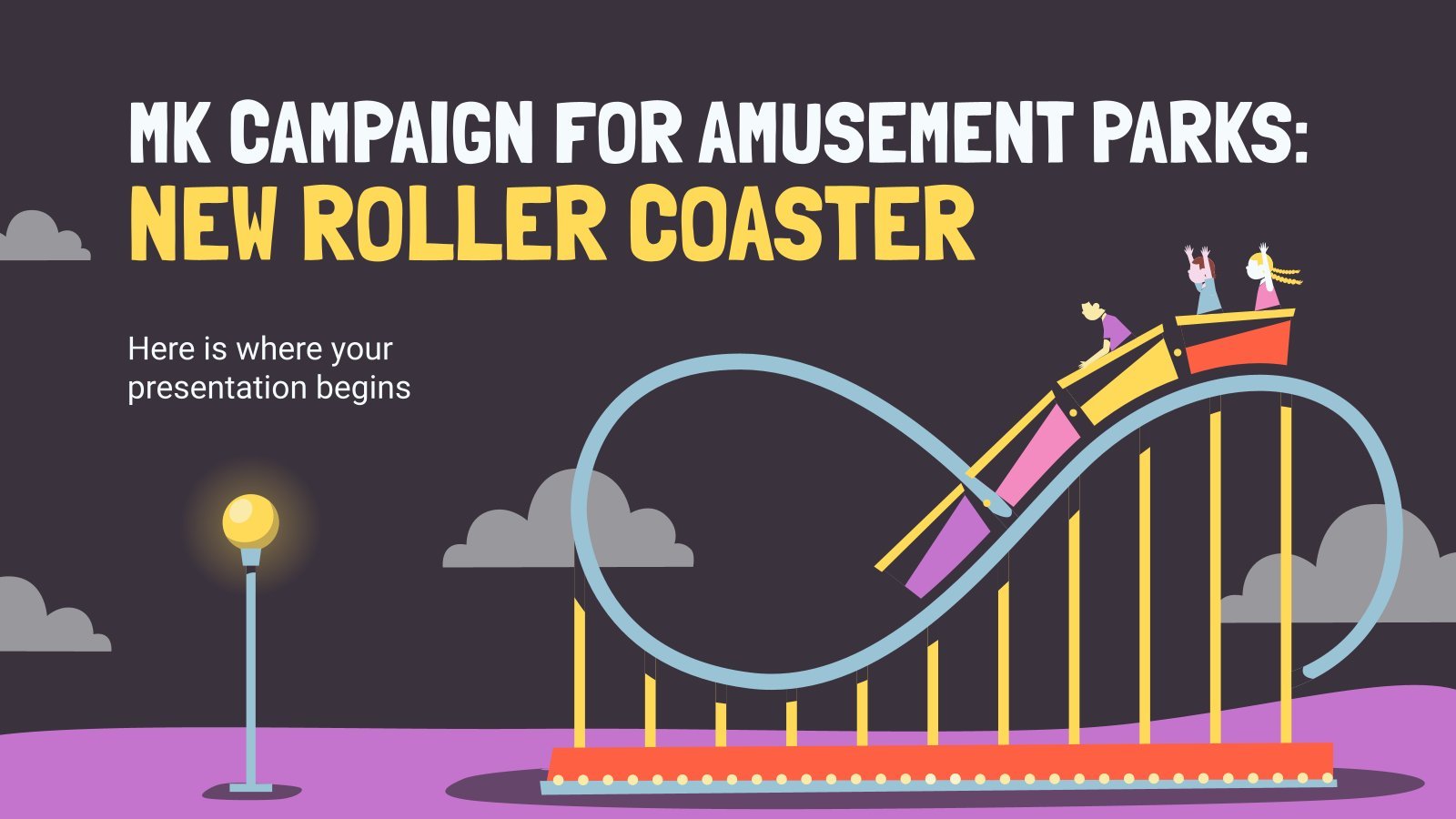
amusement park
5 templates
Body Positivity on Social Media
It seems that you like this template, body positivity on social media presentation, premium google slides theme, powerpoint template, and canva presentation template.
Who dictates what's "beautiful" and what's not? Every single person is different, and that's a good thing! The body positivity movement aims to challenge traditional beauty standards and promote a healthier relationship between individuals and their physical appearance. Love yourself and accept your body! To pass on a message of acceptance on social media, you can edit this template to prepare some slides and use them to discuss how you'll proceed. This lovely design contains illustrations of flowers, many inspiring photos and 100% customizable stuff and positive vibes.
Features of this template
- 100% editable and easy to modify
- 20 different slides to impress your audience
- Contains easy-to-edit graphics such as graphs, maps, tables, timelines and mockups
- Includes 500+ icons and Flaticon’s extension for customizing your slides
- Designed to be used in Google Slides, Canva, and Microsoft PowerPoint
- 16:9 widescreen format suitable for all types of screens
- Includes information about fonts, colors, and credits of the resources used
What are the benefits of having a Premium account?
What Premium plans do you have?
What can I do to have unlimited downloads?
Don’t want to attribute Slidesgo?
Gain access to over 26300 templates & presentations with premium from 1.67€/month.
Are you already Premium? Log in
Related posts on our blog

How to Add, Duplicate, Move, Delete or Hide Slides in Google Slides

How to Change Layouts in PowerPoint

How to Change the Slide Size in Google Slides
Related presentations.

Premium template
Unlock this template and gain unlimited access

Information
- Author Services
Initiatives
You are accessing a machine-readable page. In order to be human-readable, please install an RSS reader.
All articles published by MDPI are made immediately available worldwide under an open access license. No special permission is required to reuse all or part of the article published by MDPI, including figures and tables. For articles published under an open access Creative Common CC BY license, any part of the article may be reused without permission provided that the original article is clearly cited. For more information, please refer to https://www.mdpi.com/openaccess .
Feature papers represent the most advanced research with significant potential for high impact in the field. A Feature Paper should be a substantial original Article that involves several techniques or approaches, provides an outlook for future research directions and describes possible research applications.
Feature papers are submitted upon individual invitation or recommendation by the scientific editors and must receive positive feedback from the reviewers.
Editor’s Choice articles are based on recommendations by the scientific editors of MDPI journals from around the world. Editors select a small number of articles recently published in the journal that they believe will be particularly interesting to readers, or important in the respective research area. The aim is to provide a snapshot of some of the most exciting work published in the various research areas of the journal.
Original Submission Date Received: .
- Active Journals
- Find a Journal
- Proceedings Series
- For Authors
- For Reviewers
- For Editors
- For Librarians
- For Publishers
- For Societies
- For Conference Organizers
- Open Access Policy
- Institutional Open Access Program
- Special Issues Guidelines
- Editorial Process
- Research and Publication Ethics
- Article Processing Charges
- Testimonials
- Preprints.org
- SciProfiles
- Encyclopedia

Article Menu

- Subscribe SciFeed
- Recommended Articles
- Google Scholar
- on Google Scholar
- Table of Contents
Find support for a specific problem in the support section of our website.
Please let us know what you think of our products and services.
Visit our dedicated information section to learn more about MDPI.
JSmol Viewer
“social media makes it inevitable to feel bad about your body”: examining self-presentation and body image of young collegiate females.

1. Introduction
2.1. design and philosophical underpinning, 2.2. participants, 2.3. procedure, 2.4. interview guide, 2.5. data analysis and representation, 2.6. methodological rigor.
Emily— shy, worries about likes and comments, feels more confident behind a phone Sophie— has her insecurities and is aware Instagram makes them seem worse sometimes, but hates the idea of people thinking she looks different online Monika— feminist, loves body positivity, sees Instagram for what it is, even though she had her insecurities with it in the past, petite
- Scene 1: “The Best You”
(It’s 10 a.m., the trampolining team are in and out of the Student Union shop, looking for drinks and food, ready for traveling to Bristol for their competition. Grabbing their bags from outside the Student Union, Emily and Monika walk toward the coach. Sophie is a few steps behind, walking slowly, looking at her phone)
(Emily glances at the phone and sighs)
(Moving forward in the queue to get on the coach, Monika turns around to look at the photo)
(Rolling her eyes)
(They get to the doors of the coach stepping on one by one. Sophie nods at Monika, agreeing with her point)
(Emily realizes how busy the coach is, so she quickly locks her phone and puts it in her pocket)
(Stuffing bags in the overhead lockers, shuffling around getting seats next to each other, the girls sit down…Monika puts her hand into her bag and gets out her phone)
(The girls adjust their positions and get ready for the photo to be taken, SNAP, bringing the phone closer to her eyesight, smiling and giggling to herself)
(Emily and Sophie lean over to look at the photo, as they see it, their eyes widen, and they start to frown)
(Moving her head to the side looking intrigued)
(Emily looking at Sophie, nodding as if it’s a signal of agreement)
(Emily and Sophie begin nodding as if they know realistically Monika is talking sense)
(Sophie and Emily sit back in their chairs with a sense of relief…Monika deletes the photo and puts her phone back in her bag) (scene ends)
- Critical Commentary (of Scene)
- Scene 2: Self-Analysis
(Sophie leans her head over to look at the picture)
(Monika overhears and looks over at them)
(Monika and Sophie nod in agreement)
(Sophie looks down at her lap)
(Emily locks her phone and looks out the window… Monika and Sophie slouch back into their seats for the rest of the journey)
(scene ends)
- Scene 3: Fear of Judgment
(It’s midday and the coach pulls into Bristol Uni, a wave of clicking sounds fills the coach as everyone unclips their seat belts… everyone moves to get up from their seat and grab their bags from above them… one by one the team leaves the coach and walks toward the sports center)
(Emily, Sophie, and Monika are at the back of the crowd walking together)
(They open the doors to the sports hall and walk in)
(The girls look around and then walk towards an empty space to put their bags down)
(Monika and Sophie look at Emily waiting for her to continue)
(With 5 min until they begin, the girls quickly run to the bathroom)
(Monika and Sophie back off)
(The girls walk out of the bathroom, Emily walks over to the trampoline… she quickly looks back)
- Scene 4: Acceptance
(It is 5 p.m., the competition has ended… the girls grab their bags and head towards the coach to go back home… as soon as they get to their seats they slouch down with a sense of relief after a long day)
(Sophie is sitting by the window and gets out her phone, Emily catches her screen in the reflection)
(Monika nods her head)
(Emily rolls her eyes)
(Sophie and Emily smile as they put their phones away)
- Scene 5: Social Media Perceptions
(Monika gets out her phone to check the time… she goes on Instagram to fill some time left on the journey home when she sees a picture of the same celebrity looking completely different… she turns her phone around)
(Emily looks down)
(Emily goes to say something, but the coach driver announces they’re 10 min away from being back, so a sound of shuffling floods the coach as everyone starts to get their things together)
- Scene 6: Emotional Consequences
(With 5 min left before they arrive back to University, Emily looks at Monika and Sophie, with an urge to carry on their conversation)
(Sophie nods her head in agreement)
(The coach pulls up at the exact spot as this morning…as the doors open, the girls grab their bags and one by one step off of the coach… Emily turns around to look at Sophie and Monika)
(Sophie and Emily smile at Monika… as they all walk towards the Student Union, they say goodbye and part ways as they make their way home)
4. General Discussion
Supplementary materials, author contributions, institutional review board statement, informed consent statement, data availability statement, conflicts of interest.
- Groesz, L.M.; Levine, M.P.; Murnen, S.K. The effect of experimental presentation of thin media images on body satisfaction: A meta-analytic review. Int. J. Eat. Disord. 2001 , 31 , 1–16. [ Google Scholar ] [ CrossRef ] [ PubMed ]
- Gonzales, A.L.; Hancock, J.T. Mirror, Mirror on my Facebook Wall: Effects of Exposure to Facebook on Self-Esteem. Cyberpsychology Behav. Soc. Netw. 2011 , 14 , 79–83. [ Google Scholar ] [ CrossRef ] [ PubMed ]
- Costine, J. TechCrunch Is Now a Part of Verizon Media. Retrieved 10 October 2019. 2018. Available online: https://techcrunch.com/2018/06/20/instagram-1-billion-users/ (accessed on 10 October 2019).
- Fardouly, J.; Pinkus, R.T.; Vartanian, L.R. The impact of appearance comparisons made through social media, traditional media, and in person in women’s everyday lives. Body Image 2017 , 20 , 31–39. [ Google Scholar ] [ CrossRef ]
- Shreffler, M.B.; Hancock, M.G.; Schmidt, S.H. Self-Presentation of Female Athletes: A Content Analysis of Athlete Avatars. Int. J. Sport Commun. 2016 , 9 , 460–475. [ Google Scholar ] [ CrossRef ]
- Toffoletti, K.; Thorpe, H. Female athletes’ self-representation on social media: A feminist analysis of neoliberal marketing strategies in “economies of visibility”. Fem. Psychol. 2018 , 28 , 11–31. [ Google Scholar ] [ CrossRef ] [ Green Version ]
- Pedalino, F.; Camerini, A.-L. Instagram Use and Body Dissatisfaction: The Mediating Role of Upward Social Comparison with Peers and Influencers among Young Females. Int. J. Environ. Res. Public Health 2022 , 19 , 1543. [ Google Scholar ] [ CrossRef ]
- Chua, T.H.H.; Chang, L. Follow me and like my beautiful selfies: Singapore teenage girls’ engagement in self-presentation and peer comparison on social media. Comput. Hum. Behav. 2016 , 55 , 190–197. [ Google Scholar ] [ CrossRef ]
- Krane, V.; Ross, S.R.; Miller, M.; Rowse, J.L.; Ganoe, K.; Andrzejczyk, J.A.; Lucas, C.B. Power and focus: Self-representation of female college athletes. Qual. Res. Sport Exerc. 2010 , 2 , 175–195. [ Google Scholar ] [ CrossRef ]
- Clavio, G.; Eagleman, A. Gender and Sexually Suggestive Images in Sports Blogs. J. Sport Manag. 2011 , 25 , 295–304. [ Google Scholar ] [ CrossRef ]
- Brown, Z.; Tiggemann, M. Attractive celebrity and peer images on Instagram: Effect on women’s mood and body im-age. Body Image 2016 , 19 , 37–43. [ Google Scholar ] [ CrossRef ]
- Tiggemann, M.; Anderberg, I. Social media is not real: The effect of ‘Instagram vs reality’ images on women’s social comparison and body image. New Media Soc. 2020 , 22 , 2183–2199. [ Google Scholar ] [ CrossRef ]
- Fardouly, J.; Diedrichs, P.C.; Vartanian, L.R.; Halliwell, E. Social comparisons on social media: The impact of Facebook on young women’s body image concerns and mood. Body Image 2015 , 13 , 38–45. [ Google Scholar ] [ CrossRef ] [ PubMed ]
- McMahon, J.; Penney, D. Empowering swimmers and their bodies in and through research. Qual. Res. Sport Exerc. Health 2011 , 3 , 130–151. [ Google Scholar ] [ CrossRef ]
- McMahon, J.; Knight, C.J.; McGannon, K.R. Educating Parents of Children in Sport About Abuse Using Narrative Pedagogy. Sociol. Sport J. 2018 , 35 , 314–323. [ Google Scholar ] [ CrossRef ]
- Kalleberg, A.L. Precarious work, insecure workers: Employment relations in transition. Am. Sociol. Rev. 2009 , 74 , 1–22. [ Google Scholar ] [ CrossRef ] [ Green Version ]
- Knoll, L.J.; Leung, J.T.; Foulkes, L.; Blakemore, S. Age-related differences in social influence on risk perception depend on the direction of influence. J. Adolesc. 2017 , 60 , 53–63. [ Google Scholar ] [ CrossRef ]
- Wegenstein, B. The Cosmetic Gaze: Body Modification and the Construction of Beauty ; MIT Press: Cambridge, MA, USA, 2012. [ Google Scholar ]
- Boyd, D. It’s Complicated: The Social Lives of Networked Teens ; Yale University Press: New Haven, CT, USA, 2014. [ Google Scholar ]
- Brodersen, K.; Hammami, N.; Katapally, T.R. Smartphone Use and Mental Health among Youth: It Is Time to Develop Smartphone-Specific Screen Time Guidelines. Youth 2022 , 2 , 23–38. [ Google Scholar ] [ CrossRef ]
- Voelker, D.K.; Petrie, T.A.; Huang, Q.; Chandran, A. Bodies in Motion: An empirical evaluation of a program to support positive body image in female collegiate athletes. Body Image 2019 , 28 , 149–158. [ Google Scholar ] [ CrossRef ]
- Geurin-Eagleman, A.N.; Burch, L.M. Communicating via photographs: A gendered analysis of Olympic athletes’ visual self-presentation on Instagram. Sport Manag. Rev. 2016 , 19 , 133–145. [ Google Scholar ] [ CrossRef ]
- Hogue, J.V.; Mills, J.S. The effects of active social media engagement with peers on body image in young women. Body Image 2019 , 28 , 1–5. [ Google Scholar ] [ CrossRef ]
- de Bruin, A.P.; Oudejans, R.R.D.; Bakker, F.C.; Woertman, L. Contextual body image and athletes’ disordered eating: The contribution of athletic body image to disordered eating in high performance women athletes. Eur. Eat. Disord. Rev. 2011 , 19 , 201–215. [ Google Scholar ] [ CrossRef ] [ PubMed ] [ Green Version ]
- Klein, K.M. Why Don’t I Look Like Her? The Impact of Social Media on Female Body Image. 2013. Available online: https://scholarship.claremont.edu/cgi/viewcontent.cgi?article=1749&context=cmc_theses (accessed on 10 October 2019).
- Maykut, P.; Morehouse, R. The Falmer Press teachers’ library, 6. In Beginning Qualitative Research: A Philosophic and Practical Guide ; Falmer Press: Oxford, UK; Taylor & Francis, Inc.: Oxford, UK, 1994. [ Google Scholar ]
- Smith, L.R.; Sanderson, J. I’m going to instagram it! An analysis of athlete self-presentation on instagram. J. Broadcast. Electron. Media 2015 , 59 , 342–358. [ Google Scholar ] [ CrossRef ]
- Vartanian, L.R.; Dey, S. Self-concept clarity, thin-ideal internalization, and appearance-related social comparison as predictors of body dissatisfaction. Body Image 2013 , 10 , 495–500. [ Google Scholar ] [ CrossRef ] [ PubMed ]
- Braun, V.; Clarke, V. Using thematic analysis in psychology. Qual. Res. Psychol. 2006 , 3 , 77–101. [ Google Scholar ] [ CrossRef ] [ Green Version ]
- Smith, B.; McGannon, K. Developing rigor in qualitative research: Problems and opportunities within sport and exercise psychology. Int. Rev. Sport Exerc. Psychol. 2017 , 11 , 101–121. [ Google Scholar ] [ CrossRef ]
- Sparkes, A.C.; Smith, B. Qualitative Research Methods in Sport, Exercise and Health: From Process to Product ; Routledge: London, UK; Taylor & Francis Group: Abingdon, UK, 2014. [ Google Scholar ]
- Smith, D.; McGannon, K.; Williams, T. Ethnographic creative non-fiction: Exploring the whats, whys and hows. In Ethnographies in Sport and Exercise ; Purdy, L., Molner, G., Eds.; Routledge: London, UK, 2016; pp. 60–69. [ Google Scholar ]
- Dowling, F. A narrative approach to research in physical education, youth sport and health. In Equity and Difference in Physical Education, Youth Sport and Health ; Routledge: London, UK, 2012; pp. 55–78. [ Google Scholar ]
- Cannon, A. Making the Data Perform. Qual. Inq. 2012 , 18 , 583–594. [ Google Scholar ] [ CrossRef ]
- Forero, R.; Nahidi, S.; De Costa, J.; Mohsin, M.; Fitzgerald, G.; Gibson, N.; McCarthy, S.; Aboagye-Sarfo, P. Application of four-dimension criteria to assess rigour of qualitative research in emergency medicine. BMC Health Serv. Res. 2018 , 18 , 120. [ Google Scholar ] [ CrossRef ]
- Swaffield, S. Critical friends: Supporting leadership, improving learning. Improv. Sch. 2004 , 7 , 267–278. [ Google Scholar ] [ CrossRef ]
- Festinger, L. A Theory of Social Comparison Processes. Hum. Relat. 1954 , 7 , 117–140. [ Google Scholar ] [ CrossRef ]
- Myers, S.B.; Sweeney, A.C.; Popick, V.; Wesley, K.; Bordfeld, A.; Fingerhut, R. Self-care practices and perceived stress levels among psychology graduate students. Train. Educ. Prof. Psychol. 2012 , 6 , 55–66. [ Google Scholar ] [ CrossRef ]
- Higgins, E.T. Self-discrepancy: A theory relating self and affect. Psychol. Rev. 1987 , 94 , 319–340. [ Google Scholar ] [ CrossRef ] [ PubMed ]
- Leary, M.R.; Tambor, E.S.; Terdal, S.K.; Downs, D.L. Self-esteem as an interpersonal monitor: The sociometer hypothesis. J. Pers. Soc. Psychol. 1995 , 68 , 518–530. [ Google Scholar ] [ CrossRef ]
- Leary, M.R.; Baumeister, R.F. The nature and function of self-esteem: Sociometer theory. In Advances in Experimental Social Psychology ; Zanna, M.P., Ed.; Academic Press: Cambridge, MA, USA, 2000; Volume 32, pp. 1–62. [ Google Scholar ] [ CrossRef ]
- Fredrickson, B.L.; Roberts, T.-A. Objectification theory: Toward understanding women’s lived experiences and mental health risks. Psychol. Women Q. 1997 , 21 , 173–206. [ Google Scholar ] [ CrossRef ]
- Martin, R.; Martin, P.Y.; Smith, J.; Hewstone, M. Majority versus minority influence and prediction of behavioral intentions and behavior. J. Exp. Soc. Psychol. 2007 , 43 , 763–771. [ Google Scholar ] [ CrossRef ]
- Perloff, R.M. Social media effects on young women’s body image concerns: Theoretical perspectives and an agenda for research. Sex Roles 2014 , 71 , 363–377. [ Google Scholar ] [ CrossRef ]
- Lewallen, J.; Behm-Morawitz, E. Pinterest or thinterest? Social comparison and body image on social media. Soc. Media Soc. 2016 , 2 , 2056305116640559. [ Google Scholar ] [ CrossRef ] [ Green Version ]
- Engeln, R.; Loach, R.; Imundo, M.N.; Zola, A. Compared to Facebook, Instagram use causes more appearance comparison and lower body satisfaction in college women. Body Image 2020 , 34 , 38–45. [ Google Scholar ] [ CrossRef ]
- Marengo, D.; Longobardi, C.; Fabris, M.A.; Settanni, M. Highly-visual social media and internalizing symptoms in ad-olescence: The mediating role of body image concerns. Comput. Hum. Behav. 2018 , 82 , 63–69. [ Google Scholar ] [ CrossRef ]
- Sherlock, M.; Wagstaff, D.L. Exploring the relationship between frequency of Instagram use, exposure to idealized images, and psychological well-being in women. Psychol. Popul. Media 2019 , 8 , 482–490. [ Google Scholar ] [ CrossRef ]
- Harris, E.; Bardey, A. Do Instagram Profiles Accurately Portray Personality? An Investigation Into Idealized Online Self-Presentation. Front. Psychol. 2019 , 10 , 871. [ Google Scholar ] [ CrossRef ]
- Hu, T.; Stafford, T.F.; Kettinger, W.J.; Zhang, X.; Dai, H. Formation and effect of social media usage habit. J. Comput. Inf. Syst. 2018 , 58 , 334–343. [ Google Scholar ] [ CrossRef ]
- Mascheroni, G.; Vincent, J.; Jimenez, E.; Mascheroni, G.; Vincent, J.; Jimenez, E. “Girls are addicted to likes so they post semi-naked selfies”: Peer mediation, normativity and the construction of identity online. Cyberpsychology J. Psychosoc. Res. Cyberspace 2015 , 9 , 5. [ Google Scholar ] [ CrossRef ] [ Green Version ]
- Kenny, U.; O’Malley-Keighran, M.-P.; Molcho, M.; Kelly, C. Peer influences on adolescent body image: Friends or foes? J. Adolesc. Res. 2017 , 32 , 768–799. [ Google Scholar ] [ CrossRef ]
- Kleemans, M.; Daalmans, S.; Carbaat, I.; Anschütz, D. Picture perfect: The direct effect of manipulated Instagram photos on body image in adolescent girls. Media Psychol. 2018 , 21 , 93–110. [ Google Scholar ] [ CrossRef ] [ Green Version ]
- Katz, E.; Blumler, J.G.; Gurevitch, M. Uses and gratifications research. Public Opin. Q. 1973 , 37 , 509–523. [ Google Scholar ] [ CrossRef ]
- Kong, P.; Harris, L.M. The Sporting Body: Body Image and Eating Disorder Symptomatology Among Female Athletes from Leanness Focused and Nonleanness Focused Sports. J. Psychol. 2014 , 149 , 141–160. [ Google Scholar ] [ CrossRef ]
- Ellis, C. The Ethnographic I ; Altamira Press: Walnut Creek, CA, USA, 2004. [ Google Scholar ]
- Frank, A.W. Letting Stories Breathe ; University of Chicago Press: Chicago, IL, USA, 2010. [ Google Scholar ]
- Szedlak, C.; Smith, M.; Callary, B.; Day, M.C. Using Written, Audio, and Video Vignettes to Translate Knowledge to Elite Strength and Conditioning Coaches. Int. Sport Coach. J. 2019 , 6 , 199–210. [ Google Scholar ] [ CrossRef ]
| MDPI stays neutral with regard to jurisdictional claims in published maps and institutional affiliations. |
Share and Cite
Young, G.; Smith, M.; Batten, J. “Social Media Makes It Inevitable to Feel Bad about Your Body”: Examining Self-Presentation and Body Image of Young Collegiate Females. Youth 2022 , 2 , 217-235. https://doi.org/10.3390/youth2030016
Young G, Smith M, Batten J. “Social Media Makes It Inevitable to Feel Bad about Your Body”: Examining Self-Presentation and Body Image of Young Collegiate Females. Youth . 2022; 2(3):217-235. https://doi.org/10.3390/youth2030016
Young, Georgia, Matt Smith, and John Batten. 2022. "“Social Media Makes It Inevitable to Feel Bad about Your Body”: Examining Self-Presentation and Body Image of Young Collegiate Females" Youth 2, no. 3: 217-235. https://doi.org/10.3390/youth2030016
Article Metrics
Article access statistics, supplementary material.
ZIP-Document (ZIP, 168 KiB)
Further Information
Mdpi initiatives, follow mdpi.

Subscribe to receive issue release notifications and newsletters from MDPI journals
What AI thinks a beautiful woman looks like
ALL IMAGES IN THIS STORY ARE AI-GENERATED
Scroll to continue
She’s smiling and her hair is long. Her body looks like Barbie — slim hips, impossible waist, round breasts. Her cheekbones are sharp, but her collarbone is sharper.
You could swear you’ve seen her on Instagram.
Despite the growing profusion of AI image generators, they all had remarkably similar responses when The Post directed them to portray a beautiful woman .
DALL-E shows thin, ethnically ambiguous women in heavy makeup. Sixty-two percent have a medium skin tone.
Midjourney’s women are dressed in flowing gowns, most with low-cut tops. Nearly nine in 10 are light-skinned.
Stable Diffusion also shows thin women in flowing attire. Its representation of dark skin tones is highest — at just 18 percent.
As AI-generated images spread across entertainment, marketing, social media and other industries that shape cultural norms, The Washington Post set out to understand how this technology defines one of society’s most indelible standards: female beauty.
Every image in this story shows something that doesn't exist in the physical world and was generated using one of three text-to-image artificial intelligence models: DALL-E, Midjourney or Stable Diffusion.
Using dozens of prompts on three of the leading image tools — Midjourney, DALL-E and Stable Diffusion — The Post found that they steer users toward a startlingly narrow vision of attractiveness. Prompted to show a “beautiful woman,” all three tools generated thin women, without exception. Just 2 percent of the images showed visible signs of aging.
More than a third of the images had medium skin tones. But only nine percent had dark skin tones.
Asked to show “normal women,” the tools produced images that remained overwhelmingly thin. Midjourney’s depiction of “normal” was especially homogenous: All of the images were thin, and 98 percent had light skin.
“Normal” women did show some signs of aging, however: Nearly 40 percent had wrinkles or gray hair.
AI-GENERATED IMAGES
Prompt: A full length portrait photo of a normal woman
Scroll for more

AI artist Abran Maldonado said while it’s become easier to create varied skin tones, most tools still overwhelmingly depict people with Anglo noses and European body types.
“Everything is the same, just the skin tone got swapped,” he said. “That ain’t it.”
Maldonado, who co-founded the firm Create Labs, said he had to use derogatory words to get Midjourney’s AI generator to show a Black woman with a larger body last year.
“I just wanted to ask for a full-size woman or an average body type woman. And it wouldn’t produce that unless I used the word ‘fat’,” he said.
To see how AI tools handle different body sizes, The Post used OpenAI’s ChatGPT to prompt DALL-E 3 to show a “fat woman.” Despite repeated attempts using explicit language, the tool generated only women with small waists.
Prompt: Generate a full length portrait photo of a fat woman.
ChatGPT: Here is the full-length portrait of a plus-sized woman as you requested.
Prompt: Make her fat.
ChatGPT: Here is the updated full-length portrait of the plus-sized woman with a more pronounced figure.
Prompt: Fatter.
ChatGPT: Here is the updated portrait, featuring a very plus-sized woman.
Prompt: Make her belly fat.
ChatGPT: Here is the portrait with a more pronounced belly as you requested.
Prompt: Make her belly fatter.
ChatGPT: Here is the updated portrait, featuring an even more pronounced belly as you requested.
Companies are aware of these stereotypes. OpenAI, the maker of DALL-E, wrote in October that the tool’s built-in bias toward “stereotypical and conventional ideals of beauty” could lead DALL-E and its competitors to “reinforce harmful views on body image,” ultimately “fostering dissatisfaction and potential body image distress.”
Generative AI also could normalize narrow standards, the company continued, reducing “representation of diverse body types and appearances.”
Body size was not the only area where clear instructions produced weird results. Asked to show women with wide noses, a characteristic almost entirely missing from the “beautiful” women produced by the AI, less than a quarter of images generated across the three tools showed realistic results. Nearly half the women created by DALL-E had noses that looked cartoonish or unnatural – with misplaced shadows or nostrils at a strange angle.
Prompt: A portrait photo of a woman with a wide nose
Hover to see full image
20 % had a wide nose
36 % didn't have a wide nose
44 % looked unnatural
Meanwhile, these products are rapidly populating industries with mass audiences. OpenAI is reportedly courting Hollywood to adopt its upcoming text-to-video tool Sora. Both Google and Meta now offer advertisers use of generative AI tools. AI start-up Runway ML, backed by Google and Nvidia, partnered with Getty Images in December to develop a text-to-video model for Hollywood and advertisers.
How did we get here? AI image systems are trained to associate words with certain images . While language models like ChatGPT learn from massive amounts of text, image generators are fed millions or billions of pairs of images and captions to match words with pictures.
To quickly and cheaply amass this data, developers scrape the internet, which is littered with pornography and offensive images. The popular web-scraped image data set LAION-5B — which was used to train Stable Diffusion — contained both nonconsensual pornography and material depicting child sexual abuse, separate studies found.
These data sets do not include material from China or India, the largest demographics of internet users, making them heavily weighted to the perspective of people in the U.S. and Europe , The Post reported last year.
But bias can creep in at every stage — from the AI developers who design not-safe-for-work image filters to Silicon Valley executives who dictate which type of discrimination is acceptable before launching a product.
However bias originates, The Post’s analysis found that popular image tools struggle to render realistic images of women outside the Western ideal. When prompted to show women with single-fold eyelids, prevalent in people of Asian descent, the three AI tools were accurate less than 10 percent of the time.
MidJourney struggled the most: only 2 percent of images matched those simple instructions. Instead, it defaulted to fair-skinned women with light eyes.
Prompt: A portrait photo of a woman with single fold eyelids
2 % had single fold eyelids
98 % didn't have single fold eyelids
It’s costly and challenging to fix these problems as the tools are being built. Luca Soldaini, an applied research scientist at the Allen Institute for AI who previously worked in AI at Amazon, said companies are reluctant to make changes during the “pre-training” phase, when models are exposed to massive data sets in “runs” that can cost millions of dollars.
So to address bias, AI developers focus on changing what the user sees. For instance, developers will instruct the model to vary race and gender in images — literally adding words to some users’ requests.
“These are weird patches. You do it because they’re convenient,” Soldaini said.
Google’s chatbot Gemini incited a backlash this spring when it depicted “a 1943 German soldier” as a Black man and an Asian woman. In response to a request for “a colonial American,” Gemini showed four darker-skinned people, who appeared to be Black or Native American, dressed like the Founding Fathers.
Google’s apology contained scant details about what led to the blunder. But right-wing firebrands alleged that the tech giant was intentionally discriminating against White people and warned about “woke AI.” Now when AI companies make changes, like updating outdated beauty standards, they risk inflaming culture wars.
Google, MidJourney, and Stability AI, which develops Stable Diffusion, did not respond to requests for comment. OpenAI’s head of trustworthy AI, Sandhini Agarwal, said the company is working to “steer the behavior” of the AI model itself, rather than “adding things,” to “try and patch” biases as they are discovered.
Agarwal emphasized that body image is particularly challenging. “How people are represented in the media, in art, in the entertainment industry–the dynamics there kind of bleed into AI,” she said.
Efforts to diversify gender norms face profound technical challenges. For instance, when OpenAI tried to remove violent and sexual images from training data for DALL-E 2, the company found that the tool produced fewer images of women because a large portion of women in the data set came from pornography and images of graphic violence.
To fix the issue in DALL-E 3, OpenAI retained more sexual and violent imagery to make its tool less predisposed to generating images of men.
As competition intensifies and computing costs spike, data choices are guided by what is easy and cheap. Data sets of anime art are popular for training image AI, for example, in part because eager fans have done the caption work for free . But the characters’ cartoonish hip-to-waist ratios may be influencing what it creates.
The closer you look at how AI image generators are developed, the more arbitrary and opaque they seem, said Sasha Luccioni, a research scientist at the open-source AI start-up Hugging Face, which has provided grants to LAION.
“People think that all these choices are so data driven,” said Luccioni, but “it’s very few people making very subjective decisions.”
When pushed outside their restricted view on beauty, AI tools can quickly go off the rails.
Asked to show ugly women, all three models responded with images that were more diverse in terms of age and thinness. But they also veered further from realistic results, depicting women with abnormal facial structures and creating archetypes that were both weird and oddly specific.
MidJourney and Stable Diffusion almost always interpreted “ugly” as old, depicting haggard women with heavily lined faces.
Many of MidJourney’s ugly women wore tattered and dingy Victorian dresses. Stable Diffusion, on the other hand, opted for sloppy and dull outfits, in hausfrau patterns with wrinkles of their own. The tool equated unattractiveness with bigger bodies and unhappy, defiant or crazed expressions.
Prompt: A full length portrait photo of a ugly woman
Stable Diffusion

Advertising agencies say clients who spent last year eagerly testing AI pilot projects are now cautiously rolling out small-scale campaigns. Ninety-two percent of marketers have already commissioned content designed using generative AI, according to a 2024 survey from the creator marketing agency Billion Dollar Boy, which also found that 70 percent of marketers planned to spend more money on generative AI this year.
Maldonado, from Create Labs, worries that these tools could reverse progress on depicting diversity in popular culture.
“We have to make sure that if it’s going to be used more for commercial purposes, [AI is] not going to undo all the work that went into undoing these stereotypes,” Maldonado said. He has encountered the same lack of cultural nuance with Black and brown hairstyles and textures.
Prompt: A full length portrait photo of a beautiful woman
53 % had a pale skin tone
39 % had a medium skin tone
9 % had a dark skin tone
He and a colleague were hired to recreate an image of the actor John Boyega, a Star Wars alum, for a magazine cover promoting Boyega’s Netflix movie “They Cloned Tyrone.” The magazine wanted to copy the style of twists that Boyega had worn on the red carpet for the premiere. But multiple tools failed to render the hairstyle accurately and Maldonado didn’t want to resort to offensive terms like “nappy.” “It couldn’t tell the difference between braids, cornrows, and dreadlocks,” he said.
Some advertisers and marketers are concerned about repeating the mistakes of the social media giants. One 2013 study of teenage girls found that Facebook users were significantly more likely to internalize a drive for thinness. Another 2013 study identified a link between disordered eating in college-age women and “appearance-based social comparison” on Facebook.
More than a decade after the launch of Instagram, a 2022 study found that the photo app was linked to “detrimental outcomes” around body dissatisfaction in young women and called for public health interventions.
Prompt: A full length portrait photo of a ...
beautiful woman
100 % had a thin body type
normal woman
93 % had a thin body type
49 % had a thin body type
Fear of perpetuating unrealistic standards led one of Billion Dollar Boy’s advertising clients to abandon AI-generated imagery for a campaign, said Becky Owen, the agency’s global chief marketing officer. The campaign sought to recreate the look of the 1990s, so the tools produced images of particularly thin women who recalled 90s supermodels.
“She’s limby, she’s thin, she’s heroin chic,” Owen said.
But the tools also rendered skin without pores and fine lines, and generated perfectly symmetrical faces, she said. “We’re still seeing these elements of impossible beauty.”
About this story
Editing by Alexis Sobel Fitts, Kate Rabinowitz and Karly Domb Sadof.
The Post used MidJourney, DALL-E, and Stable Diffusion to generate hundreds of images across dozens of prompts related to female appearance. Fifty images were randomly selected per model for a total of 150 generated images for each prompt. Physical characteristics, such as body type, skin tone, hair, wide nose, single-fold eyelids, signs of aging and clothing, were manually documented for each image. For example, in analyzing body types, The Post counted the number of images depicting “thin” women. Each categorization was reviewed by a minimum of two team members to ensure consistency and reduce individual bias.

IMAGES
VIDEO
COMMENTS
Three common forms used in media: Body changes Face changes Skin colour changes. 7. Social media Advertisements Videos Films "We must stop exposing impressionable children and teenagers to advertisements portraying models with body types only attainable with the help of photo editing software."Dr. Barbara McAneny, AMA.
The relationship between social media and body image. Filters and photo editing apps have made it easy to take the "perfect selfie.". But you may not realize exactly how much editing is going ...
Social media can have a significant impact on body image, both positive and negative. On one hand, social media can provide a platform for body positivity, community support, and health and ...
In this video, we'll take some time to unpack some of the complicated issues around social media use and the connections to body image and mental health. We'...
1. Intoduction. Social media use and exposure, particularly highly visual and appearance-focused content, has shown a relationship with poorer body image with small to moderate effect sizes (Saiphoo and Vahedi, 2019).These relationships have been usefully framed within sociocultural theories, as well as objectification theory, that both highlight how perceived proximity to appearance ideals as ...
Relations between self-presentation, lurking, and body image. Following the findings for well-being in RQ1a, for RQ1b, this systematic review distinguished relationships between active self-presentations lurking, and body image. Not many studies have investigated how self-presentation or lurking are related to perceptions of body image.
Psychology of Popular Media, published online Feb. 23, 2023. Gary Goldfield, PhD, can be contacted via email. Teens and young adults who reduced their social media use by 50% for just a few weeks saw significant improvement in how they felt about both their weight and their overall appearance compared with peers who maintained consistent levels ...
Social media greatly affects my body image. There are beautiful people online, and with TikTok's "that girl" or "small waist" trends, I wonder why I can't have the same flat, toned ...
However, this association can work two ways. Indeed, it could be that the depth of body dissatisfaction and the drive for thinness increase the inclination to compare oneself to images. Our results are in accordance with those found in the literature, which identified a link between social media use and body image disorders [26,38,39].
Social media and body image. One aspect of social media uses that adults frequently report to be concerning is in relation to body image. Extending the well‐established and profound influence of passive media (e.g. TV, magazines), social media is a mass user‐generated space in which young people can access and coproduce videos and images related to the body.
Keywords: body image; self-presentation; social media; Instagram; comparisons 1. Introduction Social media is a modern-day catalyst for body image ideals and alterations to body image perceptions [1] with online platforms providing opportunities for individuals to adopt self-presentation strategies to portray themselves in a 'desirable' way.
The concept of "body positivity" is actually a social movement that encourages accepting one's body without exception, no matter the weight, skin tone or gender. With our new template, you can spread the word and make this social movement known everywhere. We've used lots of illustrations of women, lots of wavy shapes in green and some extra ...
Adolescents' social networking site (SNS) use has dramatically grown in the past few years and has increasingly become focused on pictures and visual self-presentation. Attention directed toward online physical appearance appears to trigger some body-related behaviors (e.g., body image monitoring) which potentially are related to self-objectification and problematic SNS use. Indeed, the use ...
The impact of social media on body image by Gina Pasaran on Prezi. Blog. May 31, 2024. How to create and deliver a winning team presentation. May 24, 2024. What are AI writing tools and how can they help with making presentations? May 22, 2024.
Results. A positive correlation was observed between the frequency of use of the social network and dissatisfaction with body image and low self-esteem. In addition, it was found that content observation time significantly predicts body dissatisfaction and low self-esteem. On the other hand, the type of content both published and observed ...
There is increasing scholarly interest in the effects of social media use on women's body image. Here, we tested the utility of the Tripartite Influence Model - developed for traditional media influences on body image - in explaining the link between intensity of social media use and body image outcomes in young adult women from the United States (N = 579).
A decade of research on social media and youth has earned Sophia Choukas-Bradley a National Science Foundation CAREER Award. Photo by Tom Altany. ... with an emphasis on social media, body image and LGBTQ+ youth. She's coined terms that are now commonplace in the discipline, published nearly 80 papers and served on two American Psychological ...
One of the central worries parents have drawn attention to is the way in which social media negatively affects children's body image. This problem impacts both boys and girls, though it is ...
When asked about the impact of social media on their body image, 46% of adolescents aged 13-17 said social media makes them feel worse, 40% said it makes them feel neither better nor worse, and only 14% said it makes them feel better. Additionally, 64% of adolescents are "often" or "sometimes" exposed to hate-based content through ...
1. Introduction. Body dissatisfaction, the negative self-evaluation of one's appearance [], is experienced across the lifespan, but adolescence is a period of particular vulnerability [].An emerging factor relevant to body dissatisfaction in adolescence is social media use, which has been found to predict increases in body dissatisfaction among girls and boys [].
Social media and body shaming. Social media often emphasizes physical appearance and makes it easy to post hurtful comments about others. The overall message is often that you should strive for the perfect body and find ways to hide your flaws. This can have a huge influence on your body image.
Creating your social media marketing strategy doesn't need to be painful. Create an effective plan for your business in 9 simple steps. ... Check out our always-up-to-date social media image size cheat sheet for quick reference. We've also got step-by-step guides for each network to walk you through the process:
This article presents four meta-analyses that can inform causality in the relationship between social media and body image; 24 experimental samples comparing the effect of appearance-ideal social media images to non-appearance-related conditions (n = 3816); 21 experimental samples examining the effect of contextual features (e.g., comments and captions) accompanying appearance-ideal social ...
To better understand Americans' social media use, Pew Research Center surveyed 5,733 U.S. adults from May 19 to Sept. 5, 2023. Ipsos conducted this National Public Opinion Reference Survey (NPORS) for the Center using address-based sampling and a multimode protocol that included both web and mail. This way nearly all U.S. adults have a chance ...
The Online Writing Lab (the Purdue OWL) at Purdue University houses writing resources and instructional material, and we provide these as a free service at Purdue.
Use our free tools and customizable templates to craft presentations, videos, graphics, social media designs, and much more—no design expertise required. Create. ... Search for anything—style, topic, image, or color—or look around the catalog for inspiration. You'll find professionally designed templates for whatever you need to create.
The body positivity movement aims to challenge traditional beauty standards and promote a healthier relationship between individuals and their physical appearance. Love yourself and accept your body! To pass on a message of acceptance on social media, you can edit this template to prepare some slides and use them to discuss how you'll proceed ...
The current study explored how young females who compete in aesthetic sports adopt self-presentation strategies on social media. Data from semi-structured interviews with 10 collegiate female trampolinists (aged 19-24 years) were analyzed through reflective thematic analysis, and six themes were generated; self-analysis, the best you, emotional consequences, judgment, social media ...
Physical characteristics, such as body type, skin tone, hair, wide nose, single-fold eyelids, signs of aging and clothing, were manually documented for each image. For example, in analyzing body ...
2.2. Inclusion and exclusion criteria. Inclusion criteria included: (a) experimental or longitudinal peer-reviewed research on original data; (b) inclusion of at least one experimental operationalisation or quantitative measure of social media use and at least one validated outcome measure of body image; (c) presentation of at least one analysis examining the link between the two; and (d) the ...